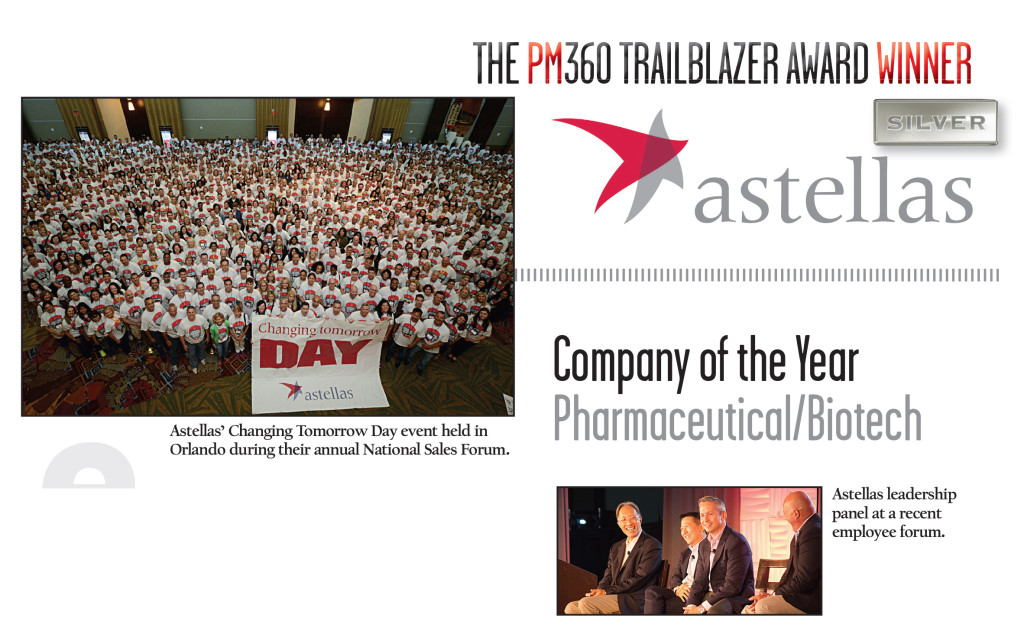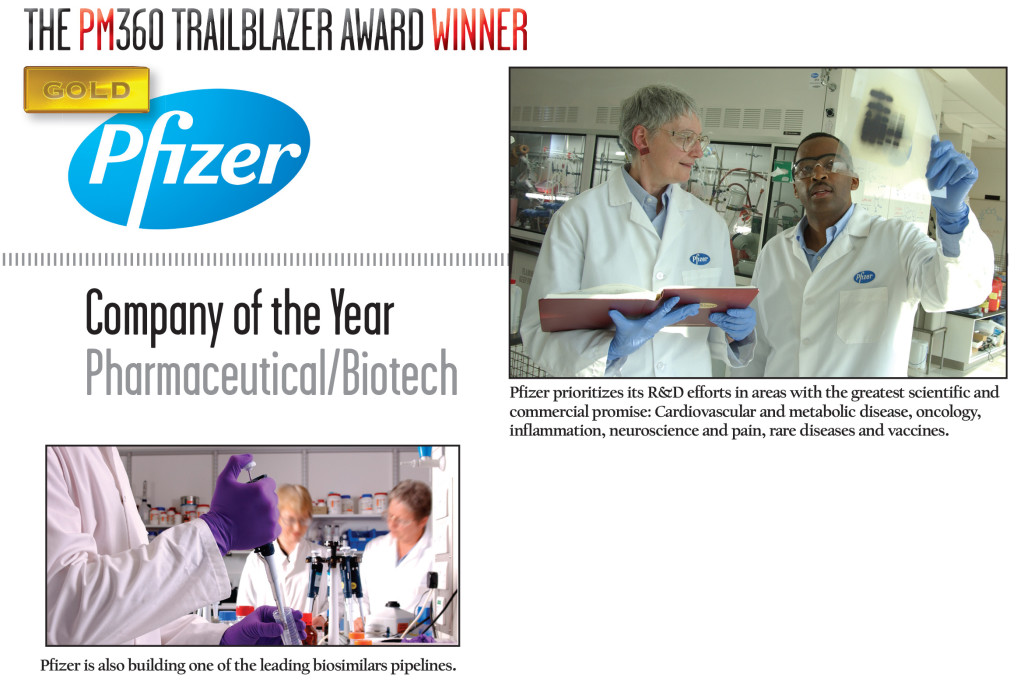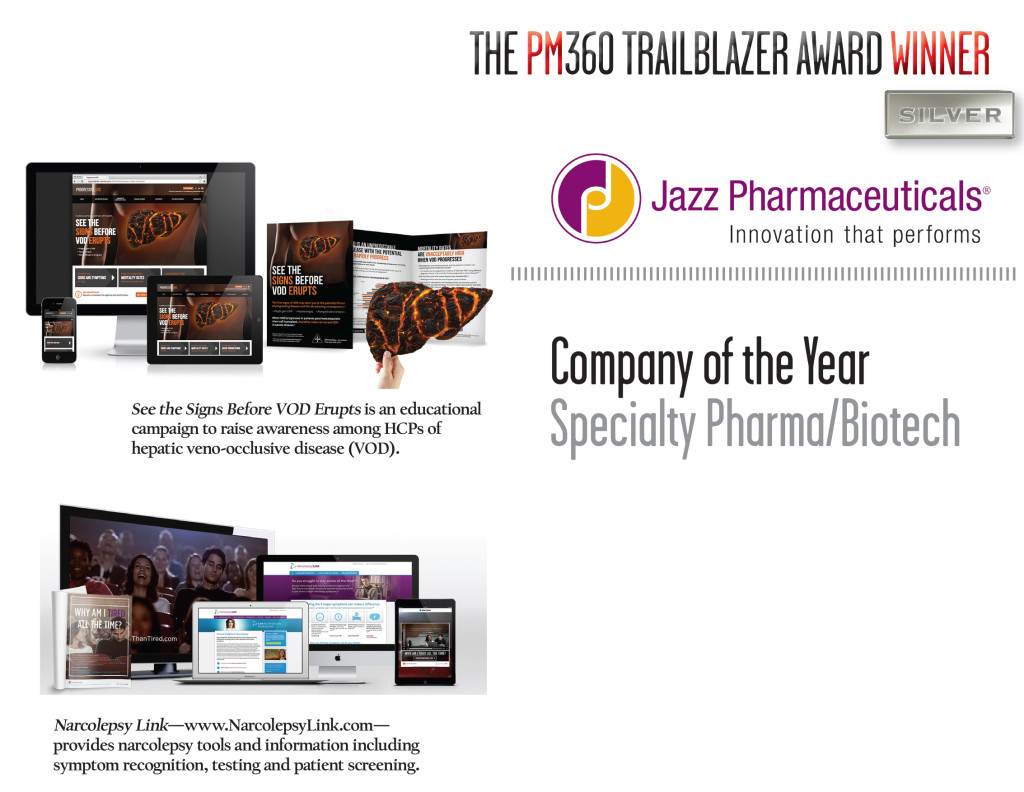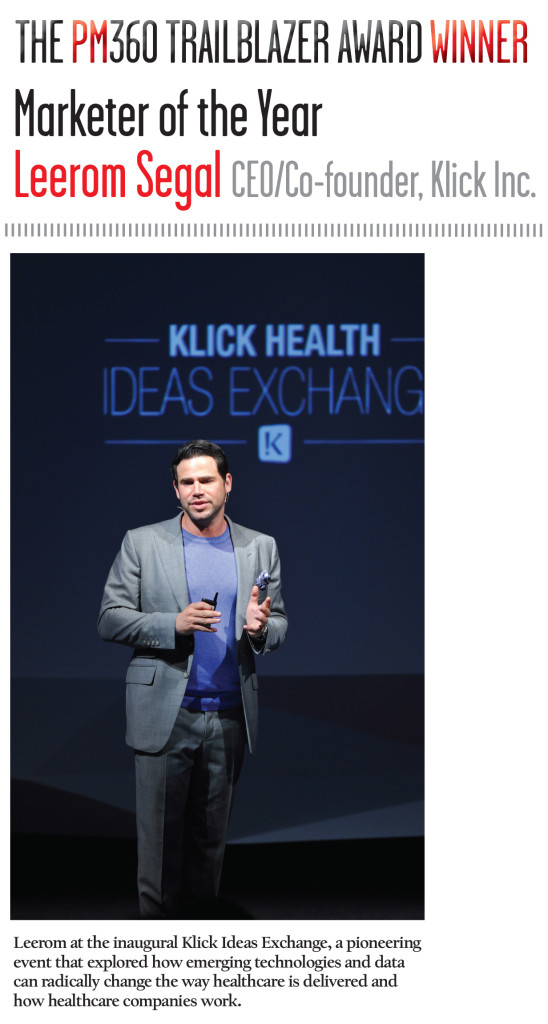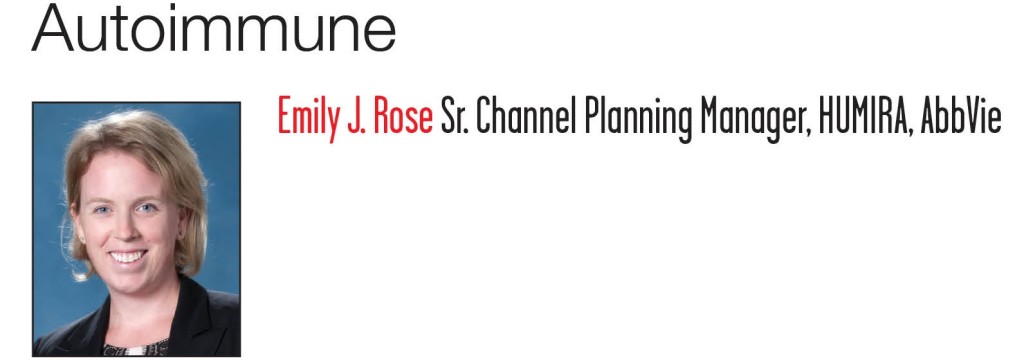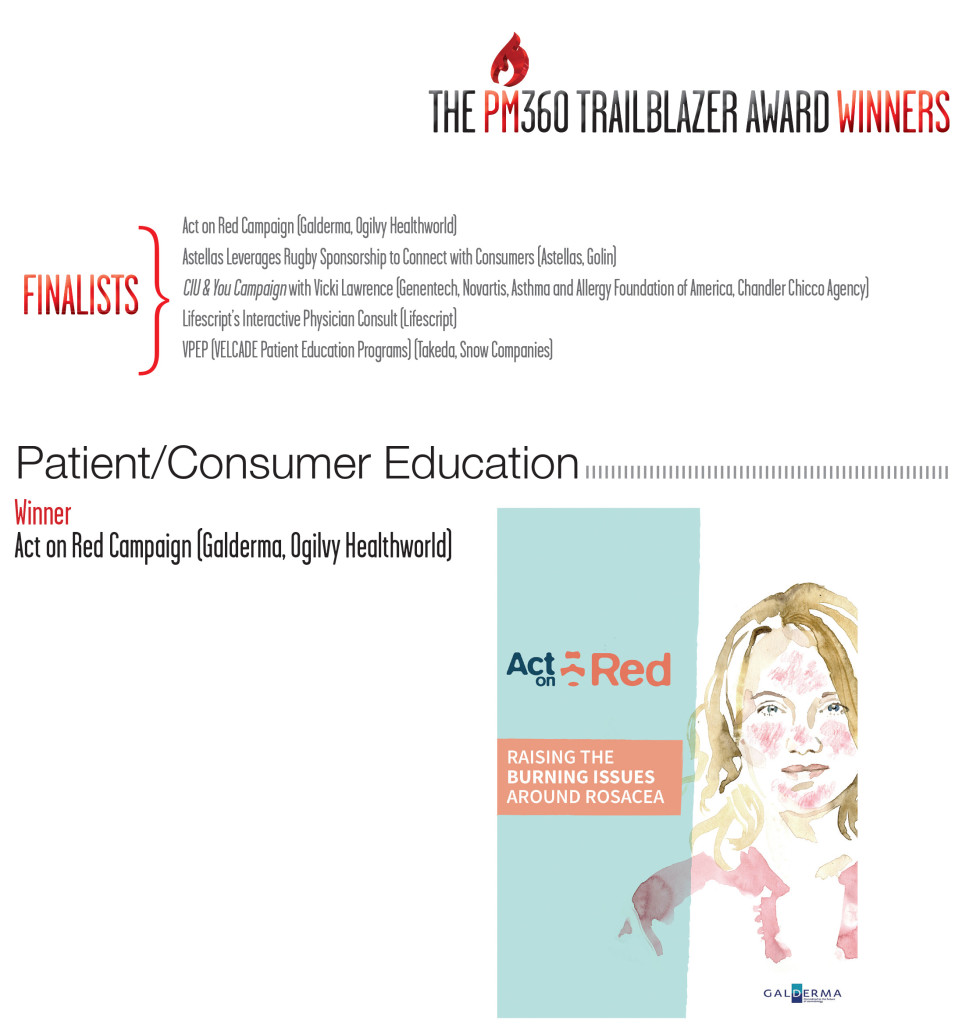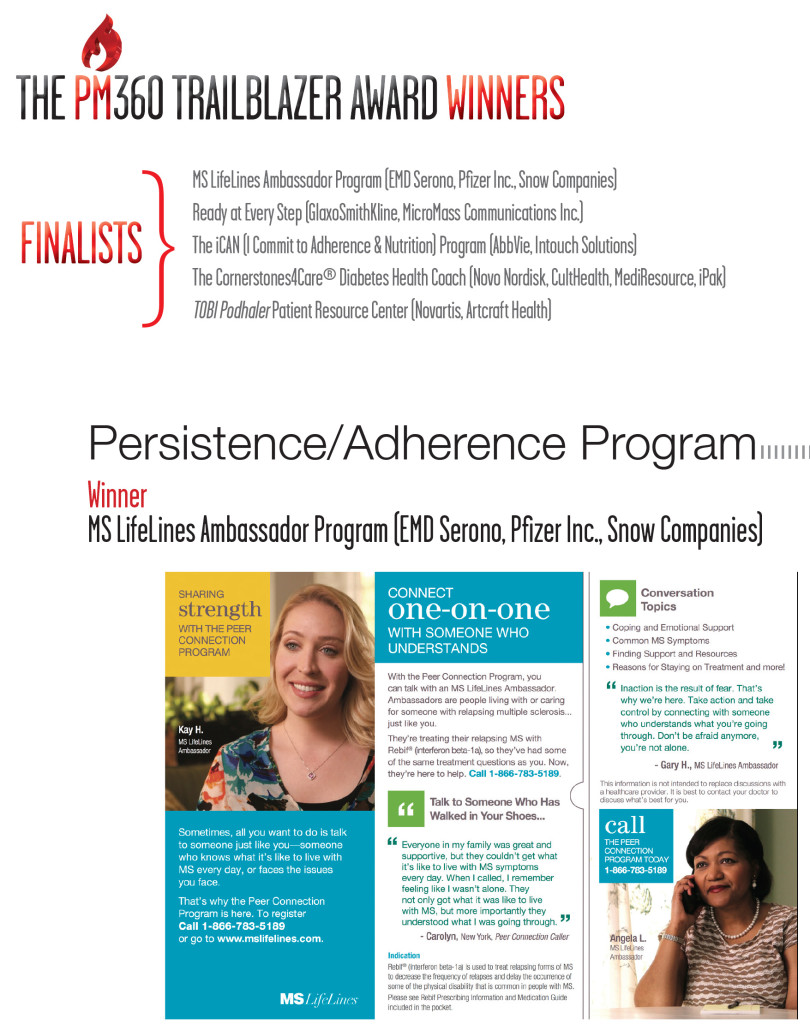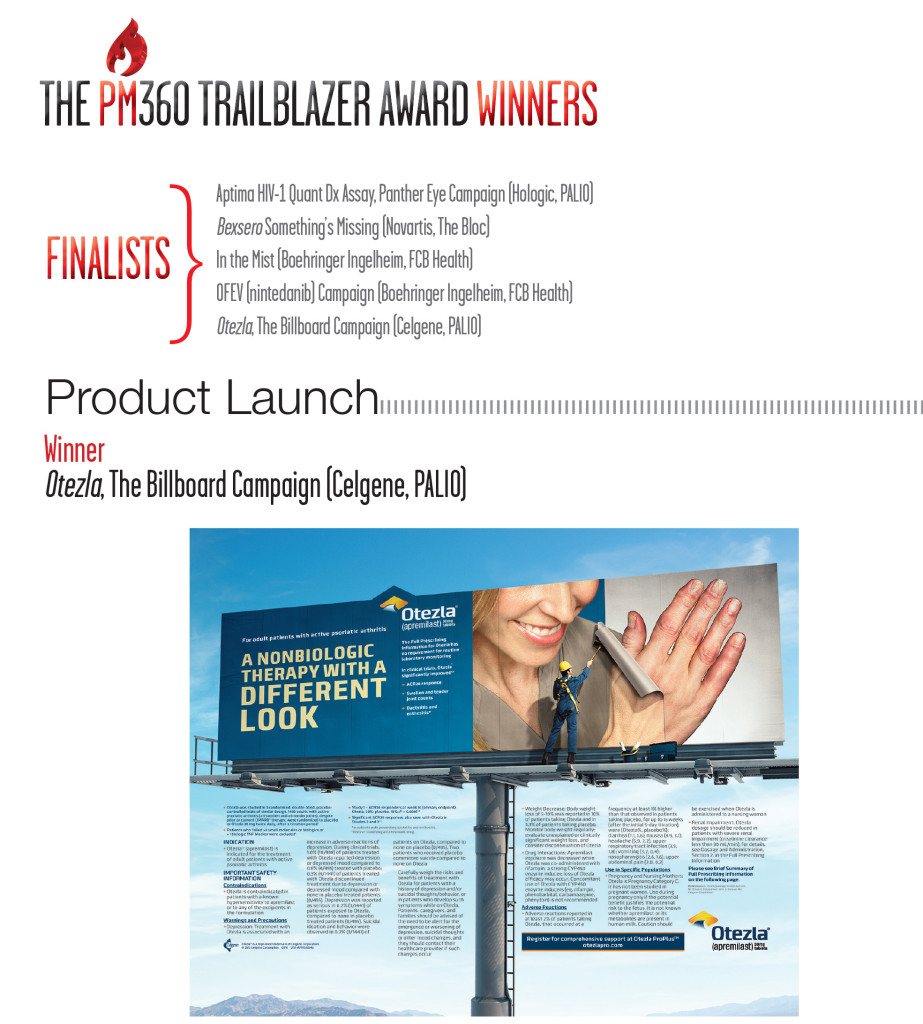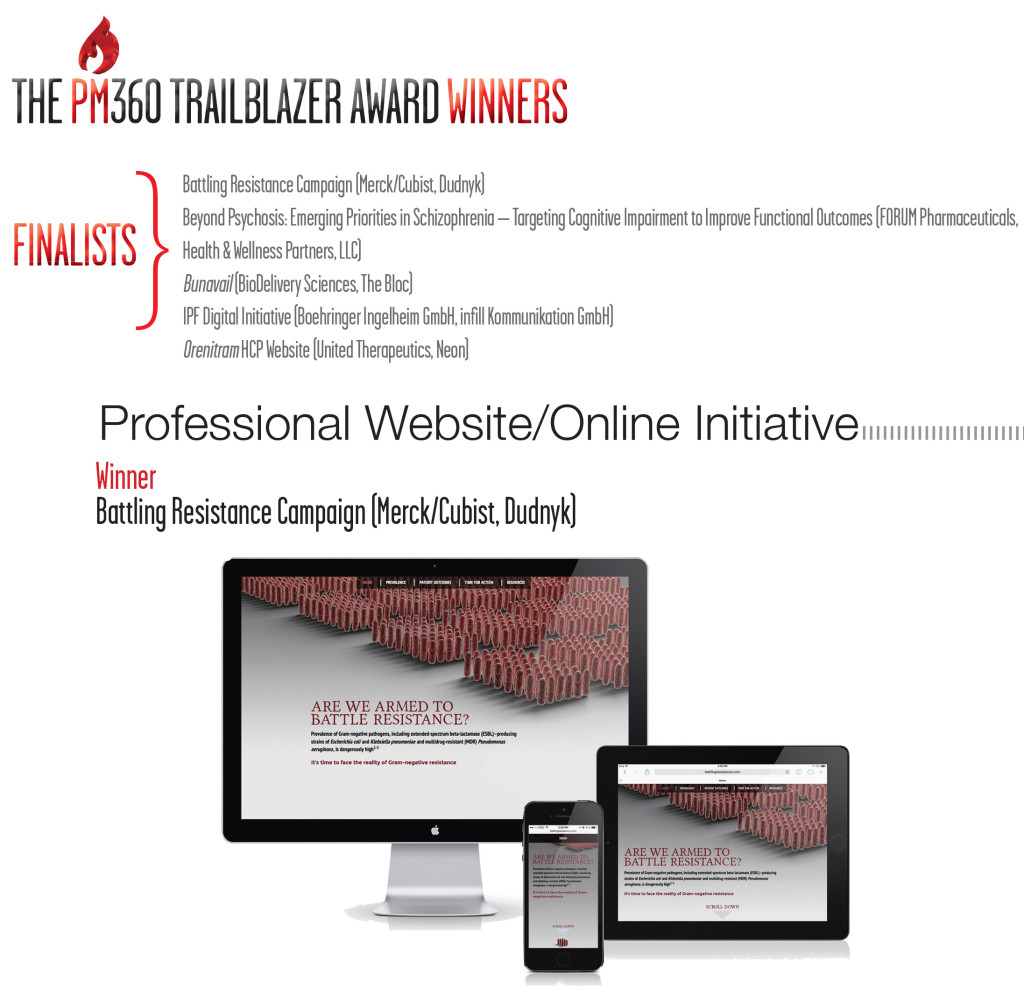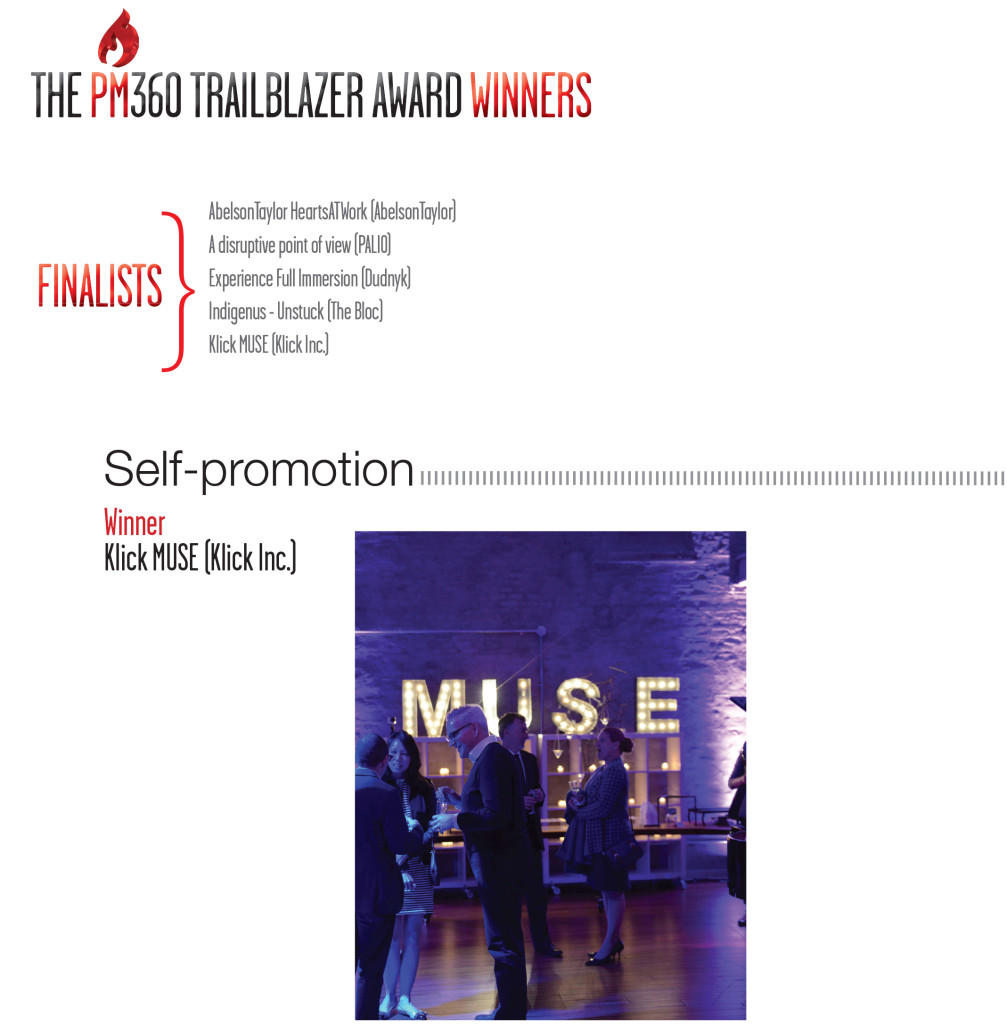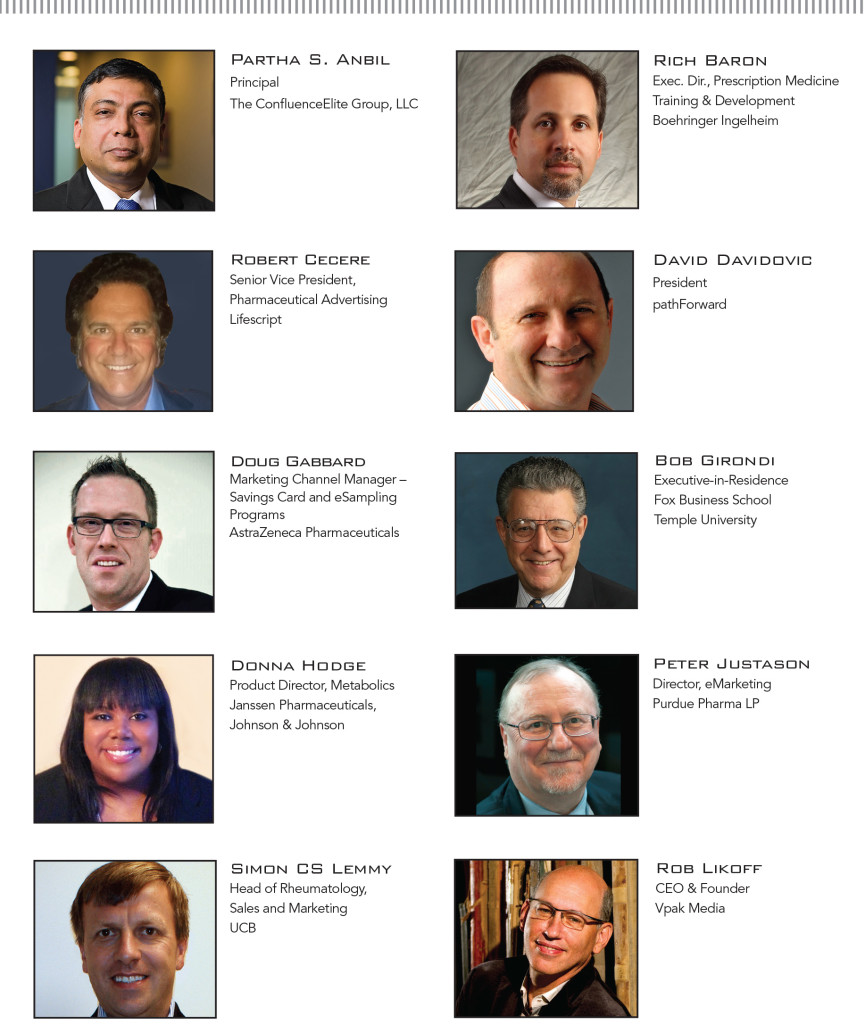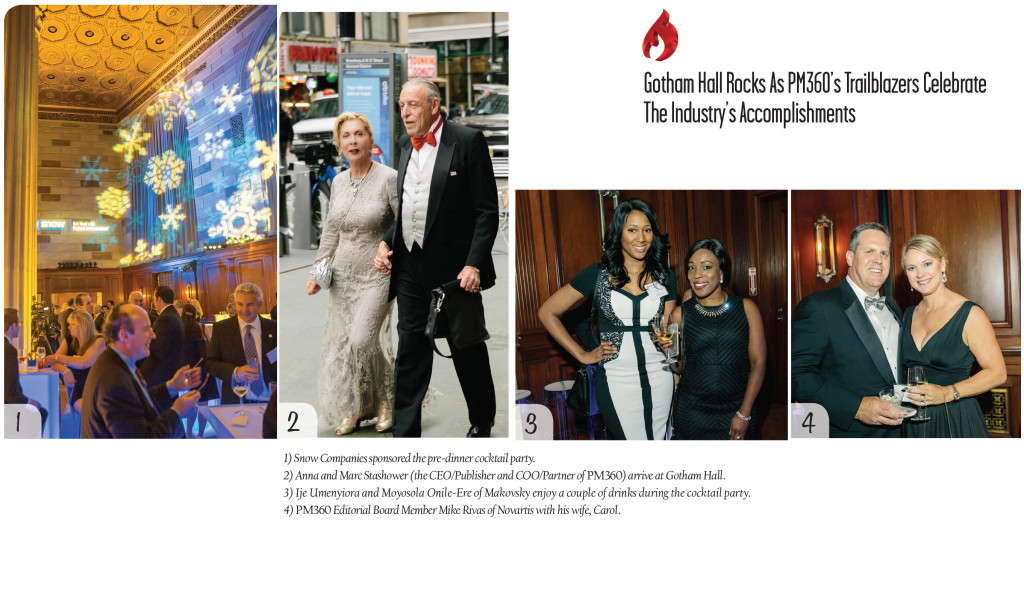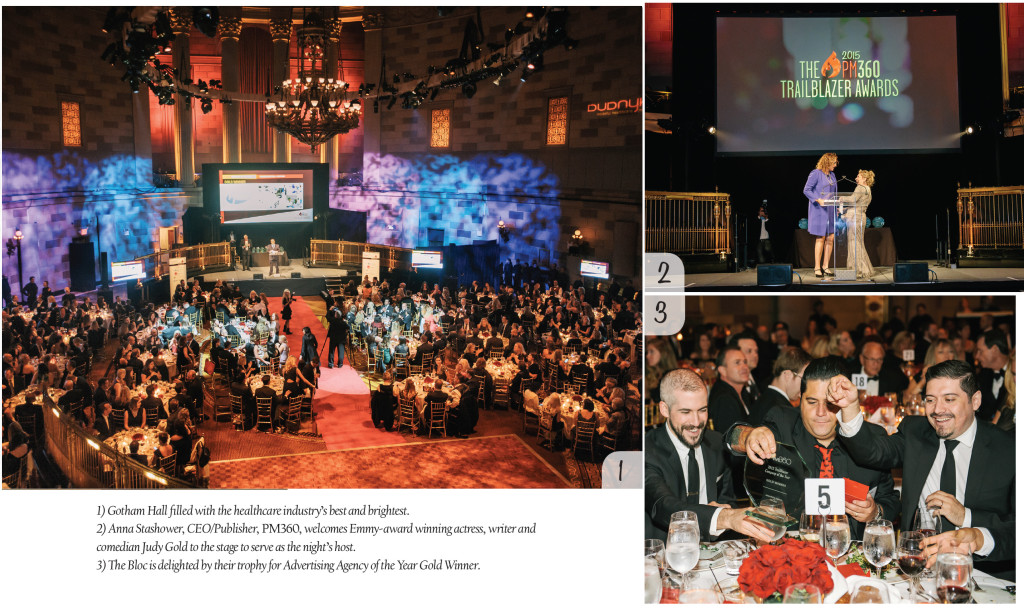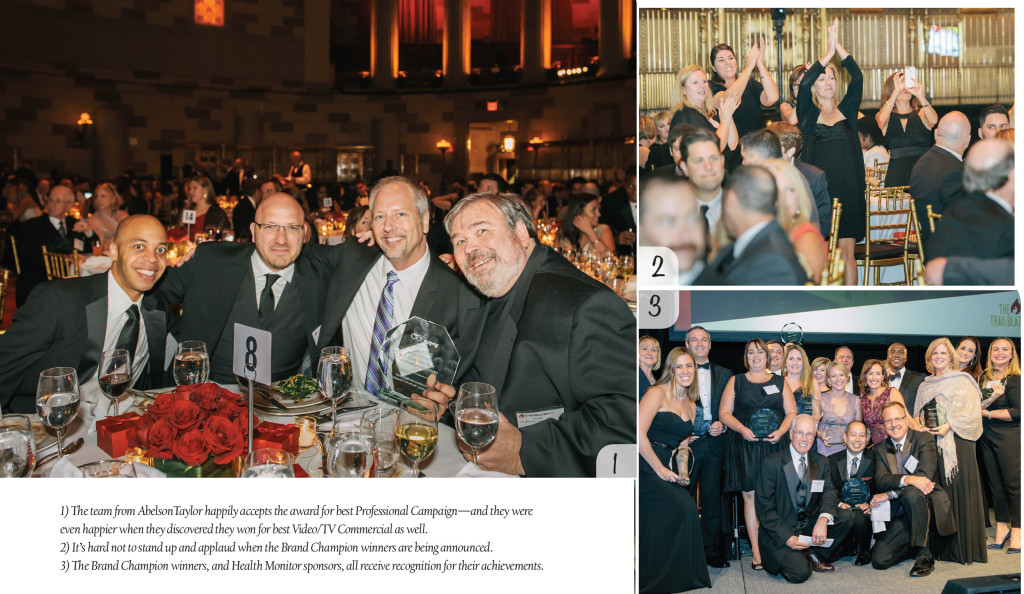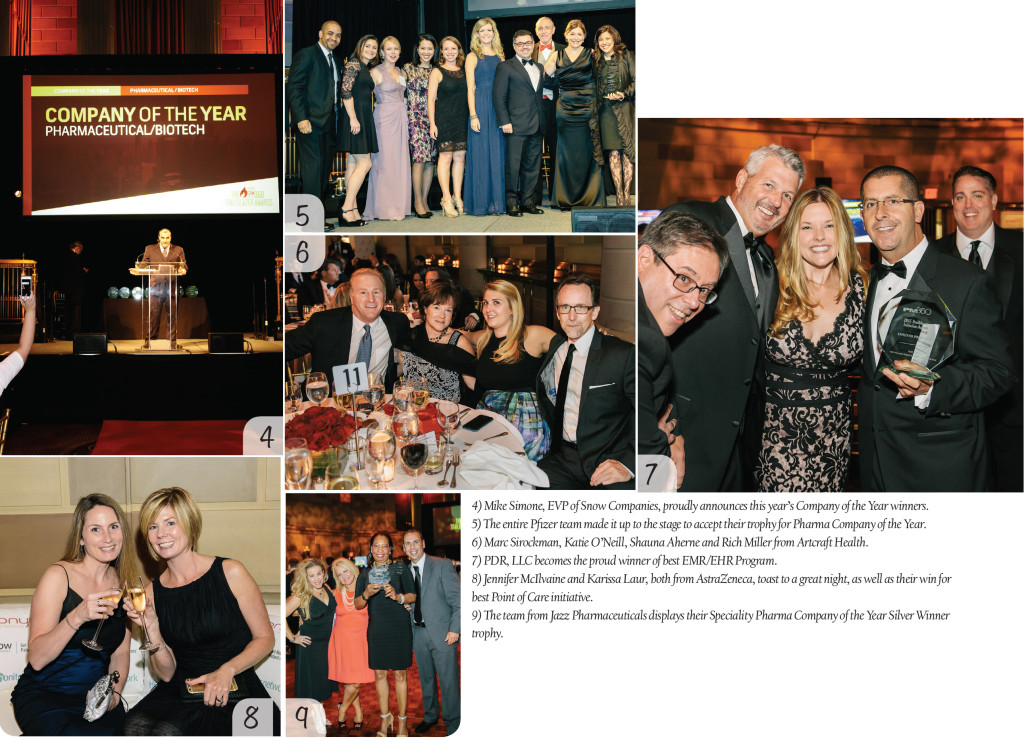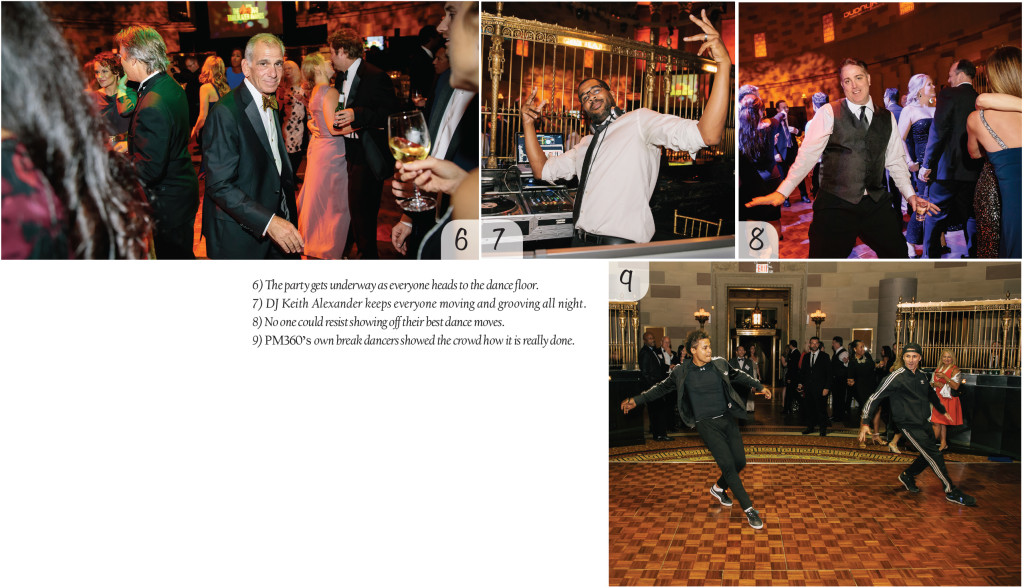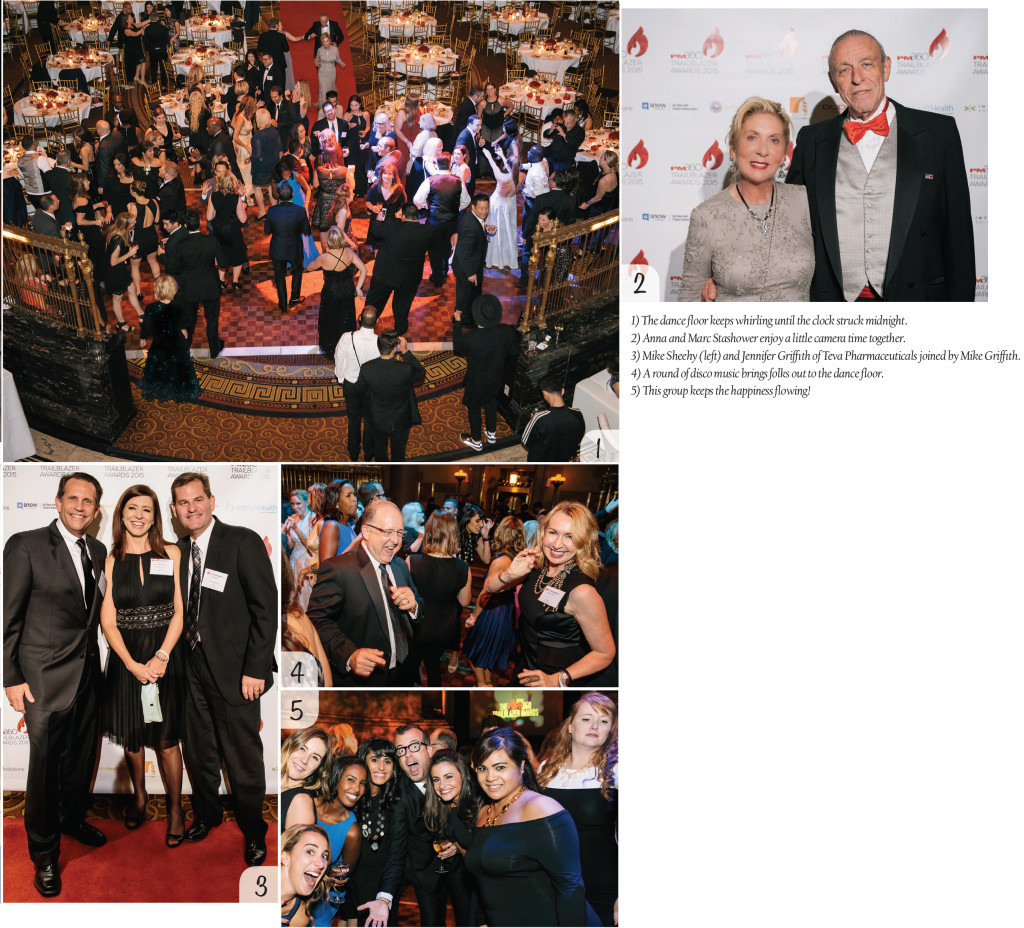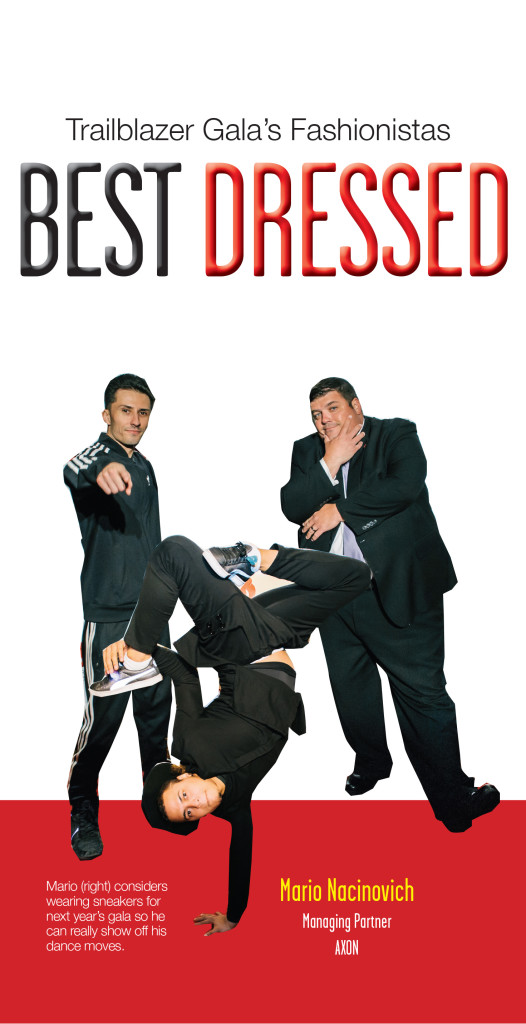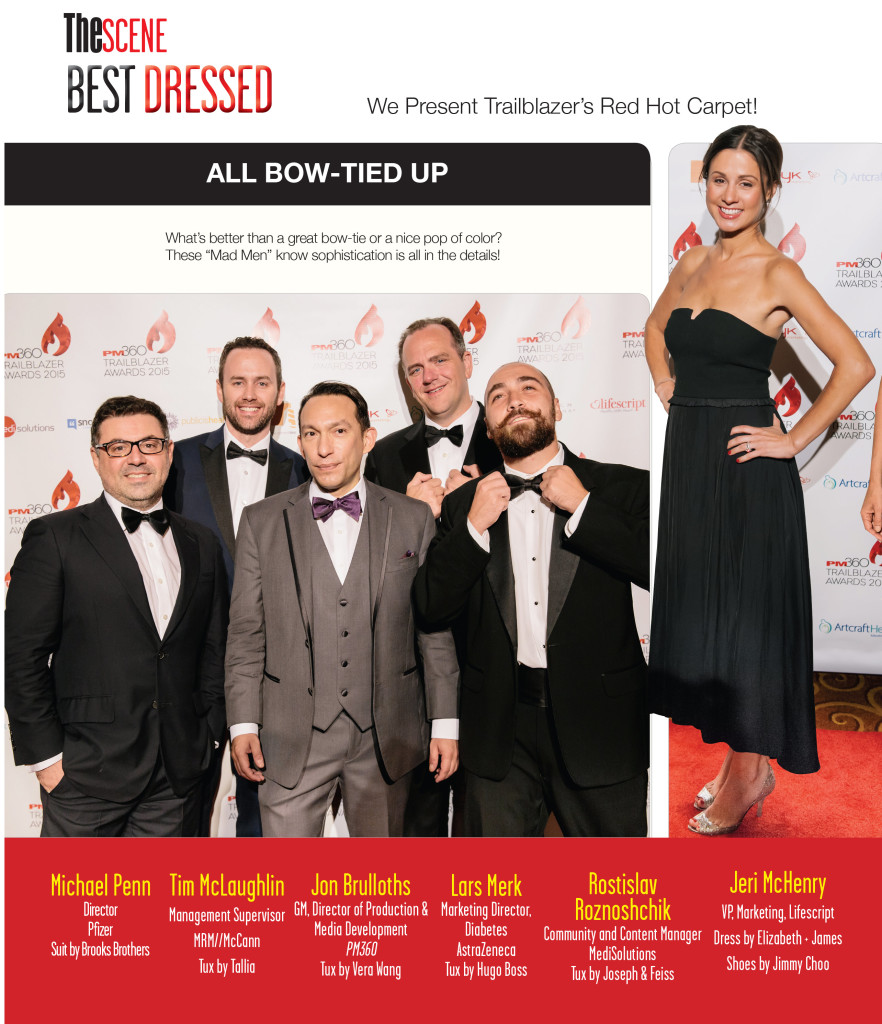Our best celebration ever. It’s just that simple. PM360’s Trailblazer Awards, now in its seventh year, is meant to laud the year’s best innovation in the healthcare industry—and we did just that by throwing the year’s very best party. Once again, winners and finalists were honored at the stately Gotham Hall in New York City—but this year’s venue rocked like never before. Our host for the evening, Judy Gold, an Emmy-award winning actress, writer and comedian, drew roars of laughter from attendees and our DJ kept the music pumping as everyone lived it up on the dance floor until after midnight. It was exactly the kind of night the people in our industry deserve—considering the countless long nights each spent working to deliver innovative new ways to help patients, physicians and caregivers.
And that brings us straight to their award-winning achievements. On the tabs below we outline the companies, people and initiatives that wowed our judges—a cross section of industry experts from our Editorial Board. While the task of selecting winners becomes more difficult every year as submission numbers grow and the competition only gets more fierce, our judges take pride in identifying the very best that the industry has to offer.
For the first time in our award’s history, we awarded both a Silver and Gold winner in our Company of the Year categories. From pharmaceutical companies to the vendors that serve them, this industry is brimming with innovation. For instance, Pfizer, the Pharma/Biotech Gold Winner, is doing incredible things digitally, which include helping to identify otherwise difficult to find patients for a clinical trial for its anti-IL-6 drug for the treatment of Lupus, and working to improve health outcomes with its “Quitter’s Circle,” a multi-platform online tool that aims to help smokers quit. Meanwhile, CMI/Compas, the Supplier/Vendor Gold Winner, is revolutionizing media buying in this industry with the first ever programmatic buying service designed to reach targeted HCPs. With so much innovation, we decided to recognize the top two companies in each of our Company of the Year categories and provide our readers with a more inclusive view of the incredible accomplishments of companies during the past year.
While we shined the spotlight on companies, we continued to honor Brand Champions and individual Initiatives, as well as our Marketer of the Year and the Lifetime Achievement recipient. This year, a true industry icon, Timothy G. Rothwell, former Chairman, President and CEO of Sanofi US, took home that honor. He undoubtedly serves as the perfect model for pharma executives to aspire to emulate. We believe all of our winners provide the inspiration for others to push this industry forward, so that next year, more people will also create something worth celebrating.
Exciting developments are taking place at Astellas, a top 20 global pharmaceutical company with 17,000 employees and a mission to improve the health of people around the world through the development and distribution of innovative and reliable prescription drugs. Recently named one of America’s Best Employers in 2015 by Forbes magazine, Astellas has increased investment in R&D while implementing a framework to better identify and accelerate promising R&D projects. The company plans to expand its research and development in key areas where it currently has a presence throughout 2017, including urology and oncology, and is also planning to expand its efforts into new therapeutic areas such as muscle disease, ophthalmology, vaccines and cell therapies.
Innovation:
- Since initiating the Astellas Innovation Management (AIM) program in 2013, Astellas is collaborating with biotechnology companies and academia to help drive innovation.
- Research operations in mitochondria-related diseases are underway through Astellas’ specialty pharma partner, Mitobridge, Inc.
- A significant number of development programs in oncology are underway, including clinical studies of compounds in prostate cancer, breast cancer, acute myeloid leukemia and non-small cell lung cancer. Furthermore, Astellas has several external collaborations underway in the oncology space.
Talent Development:
- Astellas received a perfect score on the 2015 Human Rights Campaign’s (HRC) annual Corporate Equality Index (CEI) for employee diversity.
- Working Mother named Astellas one of the 100 Best Companies in the U.S. for its commitment to establishing a corporate culture supportive of working moms and their families.
- The company implemented the Astellas Way, a set of core values and beliefs in Patient Focus, Ownership, Results, Openness and Integrity that all employees are expected to incorporate as part of their day-to-day work activities.
- With leaders from Japan, the Americas, EMEA and Asia, Astellas conducts the Executive Leadership Series and Senior Leadership Series to develop its leadership and organizational capabilities.
Social Responsibility:
- Environmental sustainability is a priority for Astellas in all aspects of its operations.
- Included on Newsweek’s annual 2015 Green Rankings for its ongoing commitment to the environment.
- Astellas hosts Changing Tomorrow Day annually, a global volunteer service initiative dedicated to creating healthier communities and making a difference for those in need. In 2015, the company has pledged 10,000 hours of service in honor of its 10th
- As part of the company’s Employee Resource Groups (ERG) initiative, employees and family members raise awareness about LGBTQ at-risk youth, homeless veterans, people living with disabilities and other areas through education, advocacy and volunteerism.
Pfizer is a success story like no other. Because innovation is at the core of what the company does, it continues to excel in all areas of its business, serving as a model of leadership and standard for the industry. Pfizer continues to invest in its talent—creating a culture that promotes entrepreneurship, innovative thinking and thoughtful risk-taking. Its social responsibility programs continue to change lives each year by giving access to millions of prescription medicines. Its unique organization works for the betterment of its patients, employees and shareholders. This is why Pfizer is the 2015 PM360 Gold Winner for Pharma Company of the Year.
Innovation:
- In 2014, Pfizer was granted FDA approvals for medicines in its vaccine, oncology and cardiovascular business units. Studies are underway in several rare disease areas.
- To demonstrate the value of its medicines to patients and payers, Pfizer created the Global Health and Value function to support improved access.
- Pfizer has taken steps to stay ahead in today’s digital age by incorporating Big Data from early product development through launch.
- Pfizer has made strides in development of educational programs targeted to specific disease groups, such as smokers. One program, called the “Quitter’s Circle,” helps smokers see their addiction as a medical condition. Another helps people with diabetic nerve pain through a program called “Step on Up,” made in collaboration with the American Diabetic Association and actor/comedian, Cedric “The Entertainer” to educate patients about symptoms and encourage them to talk to their healthcare providers.
Talent Development:
- Each year, Pfizer hosts OWNIT! Day, an initiative in which CEO Ian Reed and other senior leaders host discussions with colleagues about thriving in change.
- Its “Dare to Try” program challenges colleagues to think in new ways—in an effort to break the cycle of traditional thinking—and take thoughtful risks.
- The company maintains a culture of diversity and inclusion, and makes a concerted effort to grow and develop top talent by moving them across business units and functions.
Social Responsibility
- In 2014, Pfizer’s Rx Pathways initiative helped three million uninsured and under-insured people around the world access nearly 37.5 million Pfizer medications free or at a low-cost.
- With help from the Bill + Melinda Gates Foundation and the Children’s Investment Fund, among others, women in 69 of the world’s poorest countries were able to access contraceptive care, including Pfizer’s contraceptive, Sayana Press.
- Pfizer has also committed to provide 700 million Prevnar 13 vaccinations to help protect underprivileged infants and young children from pneumococcal disease.
Abbott’s vascular business is a global leader in cardiac and vascular care with market-leading products and an industry-leading pipeline. It is advancing the treatment of heart and vascular disease through breakthrough medical technologies that are less invasive, allowing people to restore their health and get on with their lives. But that is only one small part of what Abbott does. The company’s medical device business also includes diabetes care and vision. And last year, the company launched a new corporate brand identity: Life. To the Fullest. This new identity expresses Abbott’s commitment to helping people get as much out of their lives as possible through better health. That commitment is seen throughout the company’s operations.
Innovation:
- Abbott’s Absorb fully dissolving heart stent is a first-of-its-kind device that functions like a permanent, metallic stent by opening a blocked artery in the heart, restoring blood flow and providing relief from symptoms of coronary artery disease—leaving behind a restored vessel in a natural state, free of a permanent implant.
- The company’s MitraClip treats people with degenerative mitral regurgitation who are not good candidates for surgery—the current standard of care—because of their advanced age, frailty or other complicating factors.
- Abbott’s FreeStyle® Libre Flash Glucose Monitoring System is a revolutionary new glucose sensing technology that eliminates the need for routine finger pricks, reading glucose levels through a sensor that can be worn on the back of the upper arm for up to 14 days.
- Abbott’s two new TECNIS Multifocal IOLs offer different lens “powers” that provide people with cataracts options to have a full range of near, intermediate and distance vision, while customizing their treatment based on their personal vision needs and lifestyle.
Talent Development:
- Included on Working Mother magazine’s “100 Best Companies” list for 15 consecutive years.
- Recognized for the seventh straight year as a “Top 50 Company for Executive Women” by The National Association for Female Executives.
- Named a “Top 50 Company for Diversity” by magazine for 12 years running.
- Included on Science magazine’s “Top 20 Biopharma Employers” list 11 times, most recently in 2014.
Social Responsibility:
- Global Industry Group Leader in economic, environmental and social performance on the prestigious Dow Jones Sustainability Indexes for three consecutive years (2013-2015).
- 1 for Social Responsibility in the healthcare industry sector on the Fortune Most Admired Companies list for two consecutive years (2014-2015).
- 2015 Social Project of the Year for the company’s “Women First” program in Russia by Platinum Ounce Awards.
St. Jude Medical is dedicated to innovation in all facets—not just delivering the next breakthrough product. Of course, they do that as well. In fact, they are highly recognized for it. At Cardiostim 2014, the 19th World Congress in Cardiac Electrophysiology and Cardiac Techniques, their Nanostim Leadless Pacemaker was recognized as the industry’s most innovative product in the sector of electrophysiology and cardiac techniques. But the company is also dedicated to sustainability with a particular focus on environmental, social and economic sound business practices. Furthermore, they measure their success not only by profits, but their ability to transform the treatment of some of the world’s most expensive epidemic diseases in order to ease the burden on patients and the healthcare system as a whole. This is without question a medical device company leading the way in the development of innovative medical solutions that save and enhance lives.
Innovation:
- The CardioMEMS™ HF System is the first and only FDA-approved heart failure monitoring device that, when managed by a physician, has been proven to significantly reduce heart failure hospital admissions and improve quality of life in NYHA Class III patients. The landmark CHAMPION trial showed the ability to reduce heart failure hospital admissions by 37%. In June, 2015, the technology was named one of the medical innovations of the year at the Premier, Inc.’s 2015 Breakthroughs Conference.
- The TactiCath™ Quartz Irrigated Ablation Catheter, FDA approved in October 2014, provides electrophysiologists a real-time, objective measure of the force that the catheter applies to a patient’s heart wall during an ablation procedure. By enabling the ability to measure the amount of force applied, physicians may create more effective lesions for their patients and may even reduce serious procedure-related complications.
- Protégé SCS System for Chronic Pain is the first and only neurostimulation system that allows spinal cord stimulation (SCS) technology upgrades as they are approved—meaning chronic pain sufferers can access new therapies, stimulation modes, diagnostics or other features through software updates without the need to undergo another surgery.
Talent Development:
- The company develops a robust pipeline of diverse talented professionals positioned to deliver the current and future needs of our organization on a global basis by actively engaging in a variety of educational programs for its employees ranging from tuition assistance to global leadership development. Current programs include: Harvard ManageMentor Online Learning, Strategic Management Series, Strategic Leadership Series, Executive Leadership Program, Health Care Reform and Economics Fundamentals.
- St. Jude Medical is also dedicated to providing a safe and healthy workplace for its employees. In 2014, the company was recognized by the American Heart Association with a Start! Fit-Friendly Company Gold Level Award.
Social Responsibility:
- The company’s dedication to environmental management programs have helped in several areas including electricity consumption (i.e., saving 1,449,000 kWh per year at its Liberty, SC manufacturing facility through enhanced temperature controls) and the recycling of generated waste (a total of 1,905 metric tons in 2014).
- In 2014, St. Jude Medical and the St. Jude Medical Foundation provided approximately $25 million in cash and in-kind product donations to important causes and organizations worldwide.
Fingerpaint is 100% owned by its more than 125 employees. And when your employer gives you a piece of the company, it is going to change how you approach your job. At Fingerpaint everyone has accepted an “all for one and one for all” philosophy that is also the leading contributor to the agency’s successful development of award-winning creative solutions on digital and traditional platforms. It is why the agency has been named one of Inc. magazine’s 5000 Fastest-Growing Companies and is a Best Places to Work winner by the Business Review. And is also how the agency has achieved success in these three areas.
Innovation:
- “Create something original” is not just the company’s corporate tagline it is also a mindset. For instance, for CSL Behring’s Zemaira, Fingerpaint created a package offering patients financial, emotional and physical support. Zemaira CareZ is a dedicated support community providing access to financial assistance, wellness programs and a peer network that lets patients connect live with support specialists.
- And when Helius Medical Technologies wanted to show the world how the brain can heal itself by stimulating nerves, Fingerpaint developed a corporate brand identity and responsive website focused on the promise of advanced neurological rehabilitation by showing off the company’s flagship technology.
Talent Development:
- The egalitarian structure at Fingerpaint has become a huge talent draw as employees love the idea of a workplace free from titles and corner offices because it also means no egos.
- The agency also established Fingerpaint University to offer ongoing education opportunities for employees, including courses on brand development, strategic planning, audio/video production, social content marketing, public relations, event planning, digital and traditional tactical deployments, intelligence and analytics, and medical and scientific communications.
- More recently, the agency launched “The Juice,” a creative salon to help Fingerpainters keep their creative juices flowing and their fingers on the pulse of innovation happening across all industries with quarterly lectures featuring an array of distinguished creative professionals.
Social Responsibility:
- “Philanthropy is one of our five value pillars,” explains Founder Ed Mitzen. “It’s what we’re built on. We give not out of a sense of obligation, but because it makes us feel so proud to be able to help others.”
- In fact, nearly 60% of employees volunteer each year, and about 25% are board members for various charities.
- The agency also employs a full-time employee who coordinates its philanthropic efforts and the more than $100,000 it gives back annually to local communities.
The most creatively awarded U.S. healthwellness communications company for the past two years can put another feather in its hat—the 2015 Trailblazer Agency of the Year. The Bloc took home 75 creative awards total in 2014 and also produced three of the 10 most-awarded campaigns of 2014: Giazo Mr. Butt, Girls Right of Way and Happy Fuel. Even their employees are highly recognized: At the inaugural Creative Floor Healthcare Awards, the agency won Best Creative, Best Suit and Best Young Talent awards. But enough about why others love them. Here is why our judges selected The Bloc as the top agency in 2015.
Innovation:
- The Bloc Value Builders is a payer service offering that develops a specific value proposition for each individual payer. It has proven successful—400% growth in three years.
- Last year they launched EngineBloc, a service offering addressing clients’ needs as they evolve to customer-centric engagement models. This is achieved through digital health engagement that goes beyond communications to deliver value-added assets at the customer’s time of need.
- The Bloc’s thought leadership platform HealthWellNext launched a new initiative in 2015 called HealthAwareNext, focusing attention on a different disease condition or therapeutic area every month to create a “Year of Disease Awareness” with posts including infographic posters, contributed articles, videos, retweets and hashtags.
Talent Development:
- CopyMasons was created to fill the void of meaningful copy training in the industry with a two-year program in which junior copywriters rotate between accounts to gain more experience.
- Bloc Apprentice is an award-winning apprenticeship program that students from all over the globe apply to looking for a competitive experience that includes active participation in client assignments. In 2015, the agency received more than 500 applications, a 25% increase on the previous year.
- Core Value Awards is an annual program in which staff nominates fellow employees who personify OIPSE: Open minds, Insightful interactions, Provocative thinking, Spirited attitudes and Entrepreneurial approach. Award recipients receive financial support to embark on a professional development venture of their choosing.
Social Responsibility:
- Every December, the agency holds its highly popular “Silent Night, Auction Night” event in which employees auction off their talents and their time (including music lessons, custom artwork, gourmet meals, etc.) with the money going to charity.
- Across all of their charitable efforts, the agency generated donations of $61,000 in 2014 to causes such as Doctors Without Borders, the Livestrong Foundation, the National MS Society, the Cystic Fibrosis Foundation, the Children’s Hospital at Montefiore and the March of Dimes.
Jazz Pharmaceuticals is an international biotechnology company that lives up to its name. Inspired by jazz musicians coming together from a variety of specialties and styles, the name “Jazz” was chosen to reflect the company’s unique combination of collaboration and improvisation within structure. But it doesn’t stop with the name. Office walls are decorated with portraits of world-famous jazz musicians, and some conference rooms are named after Jazz clubs. All of this serves to remind employees of how they must work together to achieve the company’s mission: Improving patients’ lives by identifying, developing and commercializing meaningful products that address unmet medical needs. But Jazz wasn’t selected as the Silver Winner due to its name. It was how that mindset has allowed Jazz to continue to thrive in the following areas:
Innovation:
- In 2014, the company brought in $1.2 billion in total revenue—a more then 34% increase over 2013—thanks to its stable of innovative products in the areas of sleep, hematology/oncology, and pain. Jazz’s strong R&D pipeline includes the clinical development of new products, line extensions for existing products, and the generation of additional clinical data for existing products.
Talent Development:
- Employees live by the company’s five core values: Integrity, collaboration, passion, innovation and pursuit of excellence. At Jazz, how employees do their jobs is just as important as what they accomplish.
- Everything at Jazz is focused on putting patients first and being a great place to work.
- During a recent company event, Michael P. Miller, SVP, U.S. Commercial said that the success of the company will not be measured in terms of revenue, but rather “by the number of patients who receive our drugs.”
Social Responsibility:
- The company’s Corporate Giving program provides financial support to non-profit organizations that support initiatives that fill unmet needs in the therapeutic areas they focus on.
- The Medical Education Grants program helps fund high-quality education programs designed for specialty healthcare physicians and includes educational meetings, medical center grand rounds lectures, and fellowships.
- Jazz’s commitment to patients goes beyond the products through its investment in programs designed to educate and build disease awareness, shorten time to proper diagnosis, and in a variety of patient support services and patient assistance programs.
Valeant Pharmaceuticals just doesn’t stop growing. With another seven acquisitions in 2015 alone—including the $15 billion purchase of Salix Pharmaceuticals—Valeant has become one of the most valuable companies in Canada. But Valeant’s story is about so much more than growth—it was named the 31st Most Innovative Company in the World by Forbes. Valeant simply pursues innovation in a different way than traditional large pharma companies. The Valeant R&D model is based on investment (output) rather than input, which has delivered more launches than most competitors at a lower cost and lower risk without sacrificing quality or likelihood of approval. The company also excelled in each of PM360’s main criteria for judging companies.
Innovation:
- In 2014, Valeant launched 20 products in the U.S. alone, including: Luzu, Onexton and the continued expansion of the CeraVe consumer products line. But the most successful may have been Jublia, a topical treatment for onychomycosis (a common nail infection), which is now the number one prescribed product for onychomycosis among dermatologists—with annualized revenues of more than $400 million.
- The acquisition of certain assets of Dendreon Corporation in January 2015 has helped Valeant establish a strong platform in oncology that can serve as a beachhead for additional tuck-in acquisitions.
Talent Development:
- Valeant’s decentralized model empowers hard-working business leaders to focus on delivering growth and serving patients. In fact, feedback from a 2014 Valeant employee culture survey showed that approximately 87% of employees feel that Valeant is on the right track for continued growth and 80% would recommend Valeant to a friend or colleague. Employees also define the positive aspects of Valeant’s culture as performance oriented, accountable, customer focused, collaborative, diverse, ethical and dynamic.
Social Responsibility:
- The company recognizes that ongoing research and education has the potential to improve the treatment of disease, patient outcomes and the quality of healthcare. So in addition to offering educational grants supporting bona-fide educational programs covering a full range of healthcare topics, they also support investor-initiated studies to academic and community-based scientists who are interested in conducting their own research.
- In September 2014, the company expanded Bausch + Lomb’s contact lens manufacturing lines in Rochester, NY, creating 120 new jobs for the community, and by adding 3,667 solar panels they will reduce the facility’s carbon footprint by 800 tons of carbon dioxide emissions annually.
- Bausch + Lomb also provides Continuing Medical Education Grants, Independent Research Grants and Product Donations to not-for-profits for 3rd World Missions.
Dr. Theodore Search, PharmD, an infusion pharmacist, was on-call one Saturday morning when an oncology patient was discharged into his care. The patient was prescribed a new innovative treatment, but Ted had a few questions: What is the appropriate dosing for this patient? What are the appropriate protocols to ensure adherence? Could this patient afford the treatment? He wanted a channel in which he could collaborate and consult with other verified specialists in his field to quickly get these questions answered and ensure the patient had all of the necessary information. But no such channel existed.
So in 2009, he created Skipta (the Icelandic word for exchange) and established its first community: Pharmacist Society. Today, the company is the leading social network of more than 30 specialized online medical communities for verified healthcare professionals (HCPs). Skipta’s communities enable HCPs to engage in vibrant clinical collaboration within private and secure platforms per specialty, profession or disease state. Skipta is truly a company blazing new trails and one worthy of recognition.
Innovation:
- The Skipta social network of specialized online medical communities for HCPs was built on a platform that allows for constant evolution and innovation. Each community uses secure social networking technology specifically designed for enhancing the collaboration between HCPs, and in full compliance with all industry regulations.
- Neurologist Connect, for example, was developed as the first and only professional networking platform for verified neurologists. While it provides neurologists the opportunity to network and share ideas, it also offers life science companies unique access to this high value, difficult-to-reach customer segment. The community currently boasts a growing membership base of nearly 85% of all U.S. neurologists.
Talent Development:
- The Skipta management team embodies the spirit of a true community that leverages the collective genius of the organization to accomplish its goals as well as emphasizes accountability to management and to each other. The management team further motivates and shapes a winning culture by living its values and leading by example.
Social Responsibility:
- Skipta’s greatest accomplishment has been creating a more connected medical community. As one member of Cardiology Connect said, “As a physician that is continually searching web-based forums to enhance my interactions with other like-minded clinicians, I find Cardiology Connect a vital source of timely, accurate, and actionable clinical information.”
- Meanwhile, a member of Medical Directors Forum has this to say: “I have been a Skipta member for about 15 months now. I both learn from and enjoy the postings, cases and conversations…it’s something I just don’t get elsewhere.”
CMI/Compas has been innovating media planning and buying in the pharmaceutical industry for more than 25 years, and in 2014 it became the first company in the industry to offer programmatic buying reaching healthcare professionals with AdMission. The company also drew from its Own the Audience™ service to create a new level of media planning that uses data to better engage audiences. But CMI/Compas is more than just buying and planning services for pharma—they deliver the strategy behind it. The agency steers more than 400 multichannel promotional campaigns for its brand clients, and is responsible for over 30% of the industry’s digital/mobile media placements and 50% of overall multichannel placements and traffic. From top to bottom CMI/Compas deserves to be recognized as the top Supplier/Vendor in 2015.
Innovation:
- The company continues to develop its ByTarget and ByDoctor suite of products, including two new launches this year: ByDoctor Checkup, which acts as insurance that a brand’s media plan will hit all targeted goals, and ByDoctor GPS, a self-service promotional navigation system.
- AdMission, the company’s revolutionary HCP programmatic buying solution, also leverages ByDoctor data and deep industry insights to implement, activate and optimize HCP level targeted digital media purchases. In one case study, AdMission drove script writing to a 3.5% increase in one month.
- Own the Audience™, a self-funded non-personal promotion program that combines audience insights with prescriber-level measurement, has proven in recent cases to double incremental Rx growth objectives—translating to millions in incremental revenue.
Talent Development:
- In the last year, CMI/Compas has grown from 190 employees to 261 in part due to company’s strategic presence at industry events to network and recruit.
- Each employee can also create, implement and use a measurable program to track their development. And collaboration between employees is encouraged through Yammer, an internal social media platform.
Social Responsibility:
- CMI/Compas’ founder Stan Woodland is committed to giving back to the North Philadelphia community where he grew up. He pays the majority of the tuition for four freshmen at Cristo Rey High School, a new independent college preparatory school for students who could not otherwise afford a quality education.
- The company also continues its work hosting an annual Adopt-A-Family program—benefitting hundreds of families over the past 20 years.
- Its numerous other charitable work includes participating in Martin Luther King Jr. Day of Service by closing its offices and encouraging employees to volunteer such as by bagging lunches at Unitarian Society of Germantown or reading to students at St. Paul’s Baptist Church.
The term “Trailblazer”—not to mention visionary, pioneer, and author—has been used to describe Leerom Segal for more than 18 years, since he co-founded Klick at the tender age of 17. So is it any wonder that this high-energy, innovative CEO won the Trailblazer 2015 Marketer of the Year award? Hardly.
Even after having built the world’s largest independent health agency, Leerom continues to develop brilliant new marketing ideas that don’t only disrupt the pharmaceutical, biotech and medical device industries, and insurer markets, across North America, but continues to move them forward in new, nearly unheard-of directions.
Under Leerom’s leadership, Klick had a phenomenal year, growing by almost 40% year over year with five new digital Agency of Record (AoR) accounts, three new branded AoR accounts (not exclusively digital), three new global accounts and 75 new hires—bringing the total number of “Klicksters” to more than 450.
Accomplishments That Just Keep Coming
Leerom is also lauded for his contributions to the business world. He was named a 2014 EY Media & Technology Entrepreneur of the Year and a Top 40 Under 40 award winner by Direct Marketing News.
And based on the success of his New York Times bestselling business book, The Decoded Company (Portfolio/Penguin, 2014), Leerom spoke at some of the world’s leading speaker events, including TEDGlobal and the inaugural Cannes Lions Health Creativity Festival. He also took the stage at Harvard University, Hebrew University, mHealth Israel, Google and Twitter’s world headquarters. The book recently received the Gold Axiom Business Book Award and continues to make headlines in Forbes among other leading media.
If You Build It…
In late 2014, Leerom challenged his team to come up with a new way to disrupt and advance healthcare events, and curated an experimental series of engaging multi-sensory events called MUSE. These curated events feature a unique blend of inspirational TED-like talks (with speakers such as an ALS Ice Bucket Challenge Co-founder and a teen cancer researcher), electrifying musical performances, thought-provoking technology installations, and mind-blowing food in an intimate club-like environment. Launched in Boston in February 2015, these now “must-attend” events draw top-tier news media, such as the New York Times, New York Post, Chicago Tribune and industry trade publications.
Pioneering Healthcare Industry Exploration
But MUSE was just the tip of this CEO’s visionary iceberg. In June 2015, Klick hosted the Klick Ideas Exchange to kick-off the International BIO Convention and discuss the future of healthcare. Unlike anything the industry has ever seen, this exclusive, high profile, by-invitation-only event for the nation’s leading biopharma CEOs featured an all-star line up of speakers, including President Bill Clinton, Dr. Eric Topol, Dr. Ezekiel Emanuel, Dr. Daniel Kraft and biotech luminaries such as Martine Rothblatt—and larger than life technology installations, including holograms, 3D printing, virtual reality and large-scale projection mapping. Does it get better than this?
You better believe it! Klick also won more than 200 awards for its creativity and company culture in the first half of 2015 alone, as Leerom and his team continue to lead and explore new solutions and influence the industry with a unique, people-centric and technologically driven mindset.
And then there’s Leerom’s passion for philanthropy. He and his fellow co-founders believe in giving back to the community so much that its innovative Klick it Forward program is built right into Klick’s workflow and rewards employees with donation credits for their favorite charities. In 2014, Klickster donations grew by more than 10% to $94,532. And, based on the success of its 2013 trip to Rwanda, the co-founders sent another team of Klickster ambassadors to build a school in Kenya in June 2014 and build a hospital wing with Free the Children.
Without a doubt, Leerom is one of the most innovative and inspiring leaders in the industry. He is more than deserving of the term “Trailblazer.”
CEOs of pharmaceutical companies are not always seen in the most positive light. The perception among many is that pharma executives are heartless and greedy—caring more about profits than people. But that is the antithesis of Timothy G. Rothwell. For more than 40 years he taught the people in this industry exactly how a pharma executive should act. And Tim has become an industry icon not just because of how he led some of the largest pharmaceutical companies, but because of how much he cared—about everyone.
The Attributes of a Great Leader
“I have never met more people who have cited Tim Rothwell as a mentor,” says Nick Colucci CEO, Publicis Healthcare Communications Group. “That says a whole lot about Tim, because even if it’s not true it just means that people want to be close to him and want to have something that’s connected to him. He represents so many things that are so positive about what the industry was and is, not least of which is knowing that people really are the most important thing.”
Colucci, who worked with Tim as an agency partner when Tim was with Sanofi, is one of many colleagues who are all too happy to take time out of their busy schedules just to say how great Tim is as a leader, colleague and person.
Gregory Irace, who succeeded Tim as Sanofi’s CEO, calls him “a real people person and someone who has a real heart. In addition to being an inspirational leader, he was a great mentor to me and many others in the organization and industry. I still get together with Tim, maybe once a quarter for dinner, but I know lots of my peers, most of whom have moved on from Sanofi now, still have regular meetings with Tim to stay connected and get advice.”
Frank Clyburn, now with Merck, calls Tim selfless. “He really thinks about his people and doing what’s right more than what would benefit him,” says Clyburn. “Tim always cared more about what was best for you, your development and your family.”
Tim says he strongly believes in the adage: Be humble on the way up because they are the same people you will see on the way back down. “Translated this means be kind to people, respect them and always be fair to them,” he adds. “Have high expectations regarding performance and lead by example. Remember to treat your people in the same way as you would like to be treated.”
Going Above and Beyond
Alan Rubino, CEO of Emisphere Technologies—a company at which Tim serves as Chairman—found out recently that one of the firm’s employees was dealing with a difficult cancer. Since Rubino felt his previous relationships in oncology were no longer contemporary enough, he called Tim. Immediately, Tim requested to have the employee send over her medical records so he could pass them along to the best people he knew that specialize in her specific diagnosis area at Sloan Kettering in New York, MD Anderson in Texas, etc. This ensured that she received a thorough review of proposed therapy options in order to obtain a consensus opinion from top experts regarding the best overall treatment regimen.
“Needless to say, our valued employee and her family are just beside themselves regarding Tim’s kindness and what he has done to put their minds at some ease by knowing they were getting much needed professional guidance from the very best in the field,” adds Rubino. “People use the term ‘Renaissance Man’ for more people than actually deserve this distinction, but as a pharmaceutical industry executive, Tim has earned an outstanding legacy punctuated by an excellent business track record along with impeccable integrity and rare character. It would not surprise me to hear that so many fine people across the biopharma industry echo his story and even more, all will concur that he richly deserves to have been selected for this prestigious Lifetime Achievement Award!”
An Illustrious Career
Starting as a Patent Attorney at Sandoz Pharmaceuticals, Tim also had stops at Rhone-Poulenc Rorer Pharmaceuticals, Pharmacia, Burroughs Wellcome and Squibb Corporation. He eventually even went back to Sandoz—as CEO. Later, as President and CEO of Sanofi-Synthelabo, Inc., he played an instrumental role in the formation of Sanofi-Aventis US in 2004—helping to create the third-largest drug company at the time. He ran the newly formed company as CEO and President from September 2004 to February 2007, and Chairman (after it simply became known as Sanofi) from February 2007 to October 2009.
“Tim is one of pharma’s greatest leaders,” explains Fred Hassan, Partner and Managing Director, Warburg Pincus and a member of the Amgen Board of Directors. “His strategic smarts, his vibrant leadership and his personal touch—all of these have helped create one of the largest followings in global pharma.”
And that following is helping Tim in his latest endeavor as the Chairman Emeritus of the Pheo-Para Alliance, a not-for-profit organization dedicated to helping find a treatment for people suffering from pheochromocytoma and paraganglioma, which includes Tim’s daughter. Tim has worked to assemble scientists from around the world to develop animal and clinical studies to study potential treatments. He also hosts a major gala in NJ once a year to support the Alliance and to raise funds to be used in research, and every year the Who’s Who of the pharmaceutical industry show up out of respect for Tim and the cause.
Tim, ever humble, says that he is most proud of the contributions that all the companies he worked for have made to the health and welfare of millions of patients. And one of his favorite memories is being recognized as “Honorable Mentor of the Year” in 2002 by the HBA—only the second person at the time to receive this award—because he also takes an immense pride in helping his employees grow in their careers and life. Simply put, the bottom line for Tim has always been people.
“It is rare to find a senior leader who is able to strike that perfect balance in doing what’s right for the business and always keeping the people in his mind first,” explains Brent Ragans, now with Ferring Pharmaceuticals. “He never loses sight of the importance of the people.”
Let’s hope that the industry never loses sight of what a true leader looks like—Tim Rothwell has provided them with a perfect example.
Honoring the 2015 Brand Champions
Brand Champions have always held a special place in our hearts here at PM360. In fact, we have made no secret over the past seven years about how we consider these people to be the lifeblood of our industry and the very reason why PM360 exists. After all, these are the marketers who are in the trenches guiding their brands to success while finding new ways to improve patient outcomes. So when our judges told us that the competition for our Innovation Brand Champion was a dead heat and it was impossible to choose just one winner, well, we were thrilled. It just meant we get to honor more Brand Champions. And when you look at the accomplishments of the two winners in that category, it is hard to argue with the judges.
Lars Merk of AstraZeneca helped develop a program that incorporates three of the industry’s biggest trends (wearables, EHRs and population health), while Brad Updegrove of Janssen used laser-focused targeting to outmaneuver the competition and increase competitive share of voice. But they are just two of this year’s 18 winners, our largest group of Brand Champs yet. That is due, in part, to our first-ever tie but we also added a new category: Rare Diseases. The industry is shifting more of its focus to orphan drugs and rare diseases which makes this new category a no-brainer, and the winner, Jeanine Gallagher of Astellas Pharma US, a person to watch—especially since she had the extra challenge of dealing with rare disease infections (to understand why that is extra hard, see below).
Then again, all of our Brand Champs are worth watching—they are the rising stars in the industry. Just look at how Peter Grossman of AstraZeneca is developing payer programs that fit the healthcare system’s new value-based model. Or how Colleen Reinhart of Edwards Lifesciences marketed a medical device without actually targeting the people who use the device. Or how Amelia Irvine of Pfizer helped to develop one of the most talked about campaigns of the year. We can’t wait to see what all of these champions do next.
To go right to one of our winners, click on their link below:
Autoimmune: Emily J. Rose of AbbVie
Cardiology: Paula H. Palmer of Boehringer Ingelheim
Central Nervous System: Susan Mahoney of Sunovion Pharmaceuticals, Inc.
Dermatology: Debra D’Amico of Novartis Pharmaceuticals Corporation
Diabetes/Metabolic Disorders: Janie Wang of Merck & Co., Inc.
Gastrointestinal: Rich Appiah of Janssen Biotech
Hematology/Oncology: Fatima Scipione of Takeda Oncology
Infectious Disease: Christopher Connolly of Cubist Pharmaceuticals
Innovation: Brad Updegrove of Janssen
Innovation: Lars Merk of AstraZeneca Pharmaceuticals
Managed Markets: Peter Grossman of AstraZeneca Pharmaceuticals
Medical Device Diagnostics: Colleen Reinhart of Edwards Lifesciences
Men’s Health: Amelia C. Irvine of Pfizer
Ophthalmology: Wes Paterson of Alcon, a Novartis Company
Pain/Inflammation: Chris Johnson of AstraZeneca Pharmaceuticals
Rare Disease: Jeanine Gallagher of Astellas Pharma US, Inc.
Respiratory: Jared Kurtz of Boehringer Ingelheim
Women’s Health: Matthew Barry of Astellas Pharma US, Inc.
Autoimmune
Just because you already work on one of the largest brands in the world doesn’t mean there still isn’t room for growth. You just have to find innovative ways to do so, which is exactly the area in which Emily Rose excels. AbbVie was already a company dedicated to executing innovative media solutions consistent with each brand’s business strategies, but Emily was tasked with finding these solutions for HUMIRA.
One such solution is the HUMIRA RA Yahoo! Pharma Direct program. Emily played a critical role in bringing this program to fruition, which leveraged an HCP target list to serve digital impressions to physicians while surfing on Yahoo! properties, rather than the typical endemic sites. The program, which was done in partnership with Experian and IMS, provided ROI results based on script lift to physicians exposed to the site. Considering the fact that this program was so different from most of the other professional programs out there, it required extensive vetting at AbbVie, but Emily handled that with panache—just like she always does. The program ultimately saw a positive ROI and was praised for its success.
But that is just a single example of Emily’s success. Under her supervision, HUMIRA executed a massive multichannel effort with tactics ranging across TV, radio, digital, print, email, direct mail, mobile, video, social, lead gen, in-office, point of care, eDetail, convention media and search. And in the last year alone, she worked with CMI/Compas to execute 10-plus professional programs with new vendors that had previously not been used. Her efforts have led HUMIRA to exceptional growth year over year.
Cardiology
Paula Palmer lives by the mantra that any patient who is informed with relevant and understandable information is a better patient. And that a better patient is one that is involved in their healthcare, feels in control, and is able to discuss their disease, their options, and their treatment with their physician—with an aim toward positive outcomes. She has carried that with her on each brand that she has worked on, including her latest efforts with Pradaxa.
In 2010, Paula helped launch Pradaxa, the first novel anticoagulant (NOAC) on the market to treat patients with atrial fibrillation not caused by a heart valve problem. Since then she has led all consumer initiatives for the brand, including the first national online patient education program: ACT NOW. More than 1,000 patients participated in this disease and brand awareness information session, and 90% of the attendees who filled out the survey felt they learned valuable information. But that is only one example of Paula’s patient-first initiatives.
Another one of her brainchildren is PRADAXALink, which is a first in its class CRM program that includes email and physical mail components accompanied by a 24/7 live operator hotline. So far the call center has helped more than 40,000 patients and HCPs with treatment questions, savings card activations and general support needs. Meanwhile, her latest endeavor was redesigning Pradaxa’s consumer website to provide a fresh, user friendly, responsive experience. Since its launch in Dec. 2014, it has driven a traffic increase of more than 22% over the previous site.
Central Nervous System
Sunovion has a long track record of bringing therapies for CNS conditions to market. Continuing this track record, in 2014 APTIOM (eslicarbazepine acetate) was launched in the U.S. market as an adjunctive treatment, and in August 2015 Sunovion announced FDA approval of a new monotherapy indication for APTIOM, which provides an additional therapeutic option to a larger group of patients with partial-onset seizures.
Prior to this latest milestone, Susan Mahoney and her team at Sunovion worked to reinforce the company’s growing commitment to the epilepsy community. Susan knew that with three million Americans living with epilepsy and approximately one-third unable to control seizures, more was needed, including bringing new therapies to market, expanding product indications, and providing greater education.
Susan also recognized that while APTIOM was clinically well received there was a need to provide deeper understanding of the epilepsy among healthcare providers and adults living with partial-onset seizures.
Timed with Epilepsy Awareness Month in November 2014, Susan and her team worked with their agency partners to introduce two innovative educational programs: “Explore the Possibilities” and “Expert Perspectives.” Susan also led the creation of turnkey toolkits to support these programs. Each toolkit contained event invitations, an Epilepsy Awareness Month magnetic ribbon and pin, and a branded notecard.
“Explore the Possibilities” was a national broadcast for adults living with partial-onset seizures that included an epilepsy expert, a poignant patient testimonial, and a video animation explaining the different types of seizures. “Expert Perspectives,” directed to healthcare providers, featured a nationally recognized epileptologist. The programs helped further the understanding of epilepsy and seizures, answered questions about APTIOM, and reinforced Sunovion’s continued focus on people living with serious neurological conditions.
Dermatology
Yes, plaque psoriasis (PsO) is a skin disease, but Debra D’Amico and her colleagues at Novartis understood that living with psoriasis is PsO much more than that. Debra and her team wanted to develop a campaign that would reflect this deeply personal condition that affects not just your skin—but your life. MoreToPsOriasis was the result of that desire.
The campaign’s primary objective is to create a powerful voice for PsO patients that amplifies their desire and courage to learn more about their condition and seek out an effective treatment. The disease awareness website (MoreToPsOriasis.com) also helps to motivate patients to share the social and emotional impact of the disease with their family, friends and HCP to help eliminate the feelings of isolation. The site also includes disease management education resources such as psoriasis facts and statistics, lifestyle and diet tips, treatment options, doctor discussion dialogue tools, patient videos and a forum for PsO patients to share their feelings about living with PsOriasis via social networks. Singer Cyndi Lauper has even shared her PsOriasis story via a video on the site.
Within the first three months of the campaign, following its Oct. 2014 launch, more than 5,500 patients registered for the relationship marketing program and shared more than 250 patient stories via user generated content.
Our judges were blown away by the campaign. “The MoreToPsOriasis campaign struck me as a well thought out emotionally powerful project to make people (such as physicians) understand the true pain of PsO,” one judge said. “I thought it was very compelling and impactful.”
Diabetes/Metabolic Disorders
African Americans are 1.7 times more likely to have diabetes as non-Hispanic whites, according to the American Diabetes Association. That is why Janie Wang made it a priority for the brand Januvia (a prescription medication for type 2 diabetes) to reach the African Americans/black community with information about the disease and how to manage it.
Through unique partnerships with African Methodist Episcopal (AME) Churches and Health Monitor Network, Janie was able to leverage the platform that truly connects with African Americans by providing information and developing a dialogue that was coming straight from community leaders within the churches. Janie and her team further spread the word by championing PR activities in the African American communities and innovative distribution via the AME Church network. Her overall efforts helped raise awareness about type 2 diabetes as well as the importance of managing it, and inspired patients to proactively address health issues that disproportionally impact African Americans.
This is just one example of programs championed by Janie that not only have delivered strong ROIs, but have helped patients better manage diabetes by providing relevant information to them through relevant channels. When her company took notice of the success and supported expansion of her programs, that was a pretty sure sign that Janie deserved an award.
Gastrointestinal
Few attributes define a Brand Champion more than his compassion for patients and his ability to effectively partner to bring solutions to market. Recently, Rich Appiah put compassion into action by leading a team in the development of an innovative access solution for a Janssen Immunology product, by providing appropriately qualified patients assistance in obtaining the medicine when their gastroenterologist has prescribed the product.
To support appropriate access to the brand, Rich partnered with a broad, multi-disciplinary team in the development and rollout of a pioneering program, which assists eligible patients in getting the medicine in cases when insurance coverage is delayed or denied. Such a program requires a significant team effort and input from a host of interdisciplinary stakeholders. Rich worked collaboratively with a broad group and the team got the program off the ground in just four months. Now, eligible patients may receive the brand if coverage is delayed or denied. “The access program appears to be a compassionate way to ensure that patients receive required medication when coverage is not determined in a timely way,” offers one of our judges. Thanks for doing work that improves so many of the lives it touches, Rich. Congratulations!
Hematology/Oncology
Velcade, a treatment for multiple myeloma, was an established brand with new competition that Fatima Scipione actually helped to launch 10 years ago. After spending some time on the agency side of the business, she rejoined Millennium: The Takeda Oncology Company ready to rejuvenate the brand. And while her plan for how to do so was met with some skepticism—the best usually are—it proved to be a resounding success.
In 2013, Fatima launched innovative new programs for patients and nurses, such as the Velcade Patient Speakers Bureau and Velcade Patient Education Programs, which are a series of live patient education events executed across the U.S. and online via teleconference/webcast. This was the first time Takeda launched a program of this nature in a branded setting and required many hours of internal alignment, regulatory and compliance hurdles. But the results have proved that it was time well spent. Her programs have reached 2,500 patients in 2014—that’s 10% of all newly diagnosed patients.
And the rest of the numbers are just as unambiguous: More than 62% of program participants went home willing to explore Velcade as a treatment option and sharing their insights with someone else. Fatima’s hard work has increased brand awareness as well as the understanding of key adherence messaging and opt-ins to the relationship marketing program. The sales force even endorsed her accomplishments by awarding her the Millennium Cup, an internal award for top performers. All this has helped to set Velcade on a clear path to blockbuster status—and ensured Fatima would be recognized as a blockbuster marketer.
Infectious Disease
As the lead of the marketing team assigned to Cubist’s Gram-positive portfolio of products, 2013 Brand Champion winner Christopher Connolly was presented with a quandary. How can his team launch and promote a new antibiotic for the treatment of skin infections, Sivextro, in a way that would grow the brand without affecting the established 10-year-old blockbuster Cubicin’s branding and business? While this might be a challenge for most, Chris made it look simple.
Using insights from advisory boards and market research, Chris shaped and refined both the co-positioning of Cubicin and Sivextro and the main selling messages of Sivextro. With new messaging in hand, Chris closely collaborated with the sales training team to implement clear and efficient training that the sales force could quickly learn and execute in the field.
The next challenge was launching Sivextro at the same time as two new competitors. To help Sivextro stand out, Chris implemented a visually impactful campaign positioning Sivextro as the only once-daily antibiotic with a short, six-day course of therapy. But the real key was Chris’s ability to facilitate the launch of Sivextro’s website within two minutes of FDA approval.
Thanks to his efforts, three months after launch, Sivextro had nearly 10x and 4x more patients than the two competitors. But, do you want to know the truly amazing part? During this time Chris also continued promoting Cubicin through a brand new app, which helped the brand exceed its 2014 budget of more than $1 billion in sales. Yeah, we think that makes Chris more than deserving of being the first person to be named a Trailblazer Brand Champion twice.
Innovation
Our judges had a difficult time deciding between Lars Merk and Brad Updegrove for the Innovation Brand Champion, so they just chose both. It is easy to understand why it was impossible to choose. Brad delivered outstanding results to two brands within Johnson & Johnson by making a strategic recommendation: Forget broad reach—get specific.
Both brands were interested and supportive of this direction but skeptical that it could be done. After all, broad reach was working for them and as the old adage goes, “if it ain’t broke…” But Brad knew it could be done with the right partners in place. The first brand team worked with strategic partners, such as CMI/Compas, to implement an audience analysis to determine the appropriate approach for their campaign. By the end of 2014, by optimizing the non-personal promotion plan and eliminating wasteful media buys, the team shared a cost savings year over year.
The second brand was a little trickier to get on board as the ability to promote to specific audiences at such a level was unprecedented, and frankly a bit unbelievable. But Brad worked with his agency partners to showcase the possibilities, eventually leading to a strategy that took engagement to another level. The campaign used a laser-focused approach to outmaneuver the competition. Even though the brand was reaching fewer HCPs than with broad reach, monthly frequency increased dramatically—an exponential growth over the previous year’s campaign. Meanwhile, competitive share of voice increased month over month.
Innovation
Lars Merk joined AstraZeneca in 2014 from Johnson & Johnson and continues to make innovative marketing a hallmark of his ongoing success. For years, Lars has been known as a marketing innovator in the digital marketing area, but he has not stopped innovating his own style or the brands that he works with today. While digital marketing innovation continues to be important to Lars and the industry, most who know him understand that this has been part of his DNA for many years.
As the rest of the industry catches up to the rapid speed of digital innovation, Lars continually sets his eyes on the healthcare horizon to ensure that he can prepare his brands and organization to be ahead of the curve. And Lars’ evolution has led him to immerse himself in population health to be able to deliver digital marketing innovation that will be relevant in the new healthcare world order.
Notable impact over his years at Johnson & Johnson has helped secure the organization’s place among digital leaders. His work at AstraZeneca saw him take the reins of Fit2Me, a type 2 diabetes diet and lifestyle support program that is custom fit to participants; Lars joined the team during the launch and he continued to evolve the program in its first year. This unbranded program serves all of AstraZeneca’s diabetes brands and, since its launch, the program has established firm branding in a very crowded marketplace. The program leverages data, gaming technology, patient choice, industry guidelines and “creative Zen” to create an experience for patients that is highly engaging and lauded by patients and physicians alike.
Managed Markets
Everybody knows the payer market is shifting from fee-for-service to value-based payments, but the question is: How can pharma best adapt to this shift and provide payers with programs that can help improve quality and outcomes? If you still don’t know the answer to that question, then you should ask Peter Grossman, because he sure does.
Peter was responsible for overseeing the market access launch of both Farxiga and Xigduo XR and ensuring that account directors had the proper tools to educate formulary decision makers about the benefits of these new products. But he didn’t stop there. Understanding the diverse needs of the payer space, Peter actively pursued new tools focused above the brand level and designed to provide value to payer customers, members and HCPs. In all, he developed three programs: The Quality Impact Alert, the Diabetes Awareness Month educational program, and the Case Manager Tool Kit endorsed by the Commission for Case Manager Certification (CCMC).
The Case Manager Tool Kit, a much needed resource in the diabetes space, is an all-in-one packet that provides a range of information for case managers and the patients they interact with every day. This kit supplies an array of valuable tools and resources to assist case managers, patients and caregivers.
All three programs have proven successful in elevating account director conversations from drug and cost to the delivery of quality-based diabetes programs. Additionally, the two new brands had extremely strong launches and have been well received.
Medical Device/Diagnostics
Here’s a novel idea for medical device marketing: Focus on the therapy and provide education beyond the team performing the procedure. Educate the HCPs who manage the patient population that may benefit from the device even though those HCPs are not performing the procedure. Edwards’ leadership had a brilliant idea to dedicate a team to therapy awareness and asked Colleen Reinhart to lead it.
For high-risk patients and those too sick for open-heart surgery, another option was now available—transcatheter aortic valve replacement (TAVR). A major gap existed between those HCPs who diagnose and manage patients with severe aortic stenosis (SAS) and send them along for treatment and those who were performing the procedure. Patients also were not aware of TAVR as an option. After the onset of symptoms, 50% of SAS patients will die at two years if left untreated and 20% at five years without aortic valve replacement. Colleen wanted to change that.
The team connected with a smart partner who could target HCPs/patients at the point of care with a medical update magazine and a patient/caregiver guide. The medical guide provided education for HCPs on how to recognize SAS and treatment options. The patient guide focused on valve disease, SAS symptoms and treatment options so they could better engage with HCPs on the topic.
Early results have been promising. A patient survey found the education was valuable in raising awareness and driving patients to speak with their doctors, while a HCP survey found the medical magazine provided them with the education to better identify and refer the right patients for intervention.
Men’s Health
Amelia Irvine is the marketing analytics lead for Viagra, and helped develop the Viagra “The Woman” campaign. For the first time ever, the brand features a woman who is seen as unexpected and arresting, yet also empathetic. Men have responded markedly well to “The Woman” campaign, and the brand has accomplished its goals of reaffirming Viagra’s place in the market, and successfully motivating men to get diagnosed, and ask for Viagra.
When the brand set out to develop a new consumer campaign, they made a conscious effort to expand their traditional way of thinking about their target and better understand how the condition truly affects men and those around them. While it may seem counter-intuitive, given the target’s sensitivity in discussing this matter, men in their market research were actually put at ease when hearing a woman speak to them empathetically about ED and encouraging them to talk to their doctor. Market research also determined what men wanted to hear and see during ED ads, including something that would highlight efficacy of the product while providing education and breaking down the stigma.
In addition to helping Viagra improve its share performance trajectory since launch on September 30, 2014, the brand was able to become a part of the men’s health conversation again. In fact, “The Woman” campaign generated significant media pickup, with 1.6 billion media impressions, the majority of which being neutral to favorable.
Ophthalmology
The U.S. population of presbyopic patients has seen steady growth over the last 10 years, and will become the largest segment of the vision care market by 2016. Yet, the presbyopic market has historically faced low consumer awareness of contact lens options to treat the condition. Wes Paterson is taking on this challenge—leading promotional activities and the development of a portfolio approach for Alcon’s Multifocal contact lens product line since 2013.
Wes spearheaded the development of a revitalized DTC approach in the U.S. market that speaks to the mindset of the patient target. Research showed that contact lens usage in the 40+ age group continues to decline as consumers often self-diagnose and resort to over-the-counter reading glasses when they notice changes in their vision. Wes charged his agency partner, H4B Chelsea, with creating a DTC campaign that illustrates the benefit of the proprietary design of Alcon Multifocal contact lenses in a simple, straightforward manner, building on the insight that reading glasses can be a nuisance and are perceived to make a person appear up to five years older.
The campaign consists of a central, responsive-design website (LoseYourReaders.com) that features a doctor locator for patients to find local eye care professionals experienced in fitting Alcon Multifocal contact lenses, and a free trial offer of the lenses. Wes focused the team’s efforts on targeted media drivers and PR events, rather than a general awareness campaign. To date, quantitative research found the campaign concept performed significantly higher than industry norms for motivation and engagement metrics.
Pain Inflammation
These days, everyone within the industry is preaching about patient centricity. While everyone else is talking it, Chris Johnson is doing it. As the lead on the launch for Movantik, Chris led his team through a series of exercises to understand the patient’s healthcare journey so they could better understand how to approach patients suffering from opioid induced constipation (OIC). This experience taught everyone about the patient, their condition, and their struggles long before ever uttering a word about the potential solution they might bring to bear—that’s virtually unheard of in Big Pharma.
That exercise also lead to a memorable campaign that pushed the boundaries of Big Pharma. The purpose of the campaign was to cause both patients and providers to engage each other and push one another for better patient care in the area of OIC. Chris and his team partnered with BGB to develop a campaign—“OIC is Mu-nique”—which highlighted the role of the Mu-receptor and the science of OIC using New Yorker style cartoons to grab attention and educate the masses on a very serious topic.
Thousands of providers signed up to learn about OIC long before the product was even on the market. Additionally, the team saw strong engagement in their educational booths (prior to launch) and in their branded booths (post launch) at conferences, which highlighted the science and burden of the condition in a way their customers reported being “refreshing.” And to further drive the point home: Awareness levels of Movantik doubled in only a couple months after its launch to 43% and continue to climb.
Rare Disease
Rare diseases and rare disease infections are not the same. Rare diseases occur in small populations and are generally diagnosed and when possible treated. Rare disease mold infections occur in a small population but the population at risk is quite large, which means a marketer’s target HCP audience is also quite large. This is a marketer’s worst nightmare: Very little money to market to a very broad audience. And yet Jeanine Gallagher’s success in this situation makes it look like a dream scenario.
Jeanine led the efforts at Astellas to educate HCPs about invasive mold infections. Knowing she needed to reach a wide audience, she first consulted a consensus panel to help develop content—then she tested it. She became the first marketer at Astellas to utilize HWPConnect, a new, proprietary virtual advisor platform, to seek insights from approximately 60 advisors representing healthcare systems across the U.S. to assess the effectiveness of the content and her overall brand strategy.
With her content refined and a strategy in place, she released a mobile app during the brand’s pre-launch phase, which has been downloaded more than 350 times and has an average use time of four minutes per session. Jeanine and her team also launched three consecutive expert-led educational segments on QuantiaMD, a social-learning and collaboration platform for physicians—reaching 4,500 individuals. And she used PlatformQ Health’s virtual healthcare congresses to develop and broadcast an interactive session presented by three infectious disease experts—reaching 450 individuals. The marketing initiative has proven to be so successful that Jeanine was promoted—what did we say, the dream scenario.
Respiratory
Jared Kurtz was a man on a mission. He was given just five months to launch Spiriva Respimat for COPD, but even with the limited timeline he was determined to ensure that Boehringer Ingelheim’s flagship brand, Spiriva, remained the No. 1 prescribed maintenance medication for COPD in the face of increasing competition. And just meeting expectations would not be enough for him. In fact, whenever he saw something that he knew could be improved, he uttered what his agency partner would come to consider his catchphrase, “I’d like to challenge that.”
Spiriva Respimat combines the proven performance of Spiriva with the Respimat inhaler delivery system. Jared and his team identified medication delivery as an unmet need within the very competitive COPD marketplace and focused the campaign around the inhaler’s slow moving mist. “The Mission of the Mist” launch campaign effectively communicated the key clinical benefits and differentiators for Spiriva Respimat.
“Mission” has surpassed expectations due to Jared’s leadership, analytical skills and fresh thinking, and next up he is preparing to launch yet another brand in the respiratory category. But Boehringer Ingelheim can already breathe easy knowing that Jared is sure to lead Spiriva to another blockbuster year.
Women’s Health
Overactive bladder (OAB) is not an enjoyable topic to talk about. An estimated 1 in 3 U.S. adults 40 years old or over report symptoms of OAB, while 40% of all women in the U.S. experience OAB. However, that number could be much higher since many may not report the condition out of embarrassment. Charged with leading the development of Astellas’ new customer-centric educational resource portal for OAB, Matt Barry provided a place where healthcare providers (HCPs) who treat patients that may have symptoms of OAB could get information to educate these patients—even if they are not ready to admit it.
The portal provides numerous materials to help initiate those discussions with patient FAQs and checklists, a bladder diary, doctor discussion guides, an illustrated eBook Bladder Matters, and more. Two months into the program, the site received 3x the number of registrants than the average unbranded site, visitors digested 2x the amount of content than the industry average, and 55% of site visitors downloaded patient information.
But Matt is also creating fun ways for HCPs to learn more about OAB. Yes, fun. Matt helped drive attendance to Astellas’ booth at the American Urological Association conference with an educational iRacing game using Oculus Rift virtual reality technology. He also developed an app with educational questions about Astellas’ brands. The more questions they got right, the more time they shaved off their final lap time in the iRacing game. To top it off, for each booth participant, money was donated towards charity. Educational, fun and charitable. That’s like the conference booth triple crown.
Pharma’s Trailblazing Initiatives
For years, we have heard about the dedication of this industry toward achieving a more patient centric focus. Now it seems we are finally seeing the results of that mindset shift. This year’s winning initiatives all display an increased level of warmth, empathy, humor and understanding. Not only are today’s marketers listening more closely to patients, but they are also applying what they learn, then delivering better tools or programs that offer patients what they want and need. Campaigns are speaking clearly to patients’ real experiences. They are not simply skipping ahead to showcase happy people in a field of sunflowers—a not very realistic look at the end result of treatment. And that’s exactly what patients expect today: A sense of authenticity. Take our Persistence/Adherence winner—Snow Companies. Their MS LifeLines Ambassador Program offers patients the opportunity to connect with real patients all going through the same journey—the people who can offer genuine advice as to what it’s like to live with the condition and the benefits of remaining on treatment.
But in addition to being authentic, healthcare marketers are also loosening up a bit. For instance, Pfizer, BBDO and RAPP made a Viagra DTC campaign that was, dare we say, a bit sexy. For the first time ever, the campaign features a woman who is seen as unexpected and arresting, yet also empathetic. Meanwhile, our winning Video from AbelsonTaylor and Takeda made a campaign about constipation light-hearted and even a little fun using animated balloon animals. Most of our 18 winning Initiatives share similar—and surprising—stories. The patient is put first—and the initiative is built around them. Healthcare marketers are stepping up and definitively changing how things are done. This year’s winners are living proof of what happens when they masterfully brings all these elements together.
To go right to one of our winners, click on their link below:
APP/DIGITAL SOLUTION OR SUITE
Procrit Health View App (Janssen Products, LP, Sudler & Hennessey)
CONSUMER WEBSITE/ONLINE INITIATIVE
DIRECT-TO-CONSUMER CAMPAIGN
VIAGRA Campaign (Pfizer, BBDO, RAPP)
DIRECT-TO-PATIENT CAMPAIGN
Kineret NOMID Direct-to-Patient Campaign (Swedish Orphan Biovitrum AB, The Bloc)
EMR/EHR PROGRAM
PDR Prescriber-Patient Encounters of the EMR Kind (PDR, LLC)
HCP EDUCATION
The EPI Challenge Sales Aid (AbbVie, Intouch Solutions)
INTERACTIVE MARKETING PROGRAM
Sunovion Answers: LATUDA eCRM (Sunovion, MRM//McCann)
PATIENT/CONSUMER EDUCATION
Act on Red Campaign (Galderma, Ogilvy Healthworld)
PERSISTENCE/ADHERENCE PROGRAM
MS LifeLines Ambassador Program (EMD Serono, Pfizer Inc., Snow Companies)
POINT OF CARE
SEROQUEL XR 14-day Sample Kit for Bipolar Depression (AstraZeneca)
PRODUCT LAUNCH
Otezla, The Billboard Campaign (Celgene, PALIO)
PROFESSIONAL CAMPAIGN
Symbicort “Rev the Fev” Campaign (AstraZeneca, AbelsonTaylor)
PROFESSIONAL WEBSITE/ONLINE INITIATIVE
Battling Resistance Campaign (Merck/Cubist, Dudnyk)
SALES AID
Oxistat Sales Aid (PharmaDerm, Natrel)
SELF-PROMOTION
SOCIAL MEDIA CAMPAIGN
Free Killer Tan (Mollie’s Fund, Area 23)
UNBRANDED CAMPAIGN
CREON Solutions at the Shelf Program (AbbVie, Rx EDGE Pharmacy Networks, Digitas Health)
VIDEO/TV CAMPAIGN
Amitiza Commercial (Takeda Pharmaceuticals, AbelsonTaylor)
App
When Apple HealthKit was first announced, the industry started buzzing about the possibilities. This tool for app developers represented a significant shift in the way consumer devices would interact with consumer health data and with enterprising health IT systems. It didn’t take long for Janssen and Sudler/Team Chemistry to realize the potential opportunity, as they were among the first to develop a branded healthcare app to sync with Apple HealthKit—the Procrit Health View app.
Procrit is already one of the most prescribed drugs of all time, because it reliably increases red blood cell counts for anemic patients at risk. The brand has been around for 25 years, and Janssen is continuously looking for new ways to support their patients. Anemic patients with terminal cancer, chronic kidney disease, HIV, or facing major surgery are at potential risk from dangerously low red blood cell levels.
The Procrit Health View app was designed to help these patients not only track vital health parameters but also share information with physicians in real time. Health View empowers patients to feel more in control of their health. Health measurements can be pulled in from Apple HealthKit, which can sync with the Apple Watch and other wearables, or patients can add them manually. Input is then charted by incidence and level of severity, providing contextually richer data for physicians. With this information, physicians can be alerted to their patients’ needs in order to help them be less at risk.
Consumer Website/Online Initiative
Lifescript was interested in learning more about where patients like to spend their time online, what types of entertainment programming they like and which programs are their favorites. So they asked them. Over the course of five years the company conducted in-depth interviews with people living with various chronic conditions including: Multiple sclerosis (MS), rheumatoid arthritis, psoriasis, Crohn’s disease, colitis, depression, HIV and diabetes.
Of course, a lot of people’s answer to that last question was “Breaking Bad,” after all it is the story of a man who beats cancer and starts a successful business. But in all seriousness, that is the kind of story patients wanted to hear from other patients. Not just how patients are able to reduce symptoms, prevent disease progression and manage a disease, but how they are going after their dreams, improving the world and generally “doing cool stuff.” Lifescript found this type of content sorely lacking across endemic online health publishers, so they created it.
Life Unscripted is a new series, produced in partnership with Coup Entertainment. Each episode tells the whole story of a person living with a chronic condition, in the form of a multi-part documentary short. The first installment is about a young filmmaker named Gabe who was diagnosed with MS just over a year ago. The documentary follows Gabe as he explores his diagnosis, while creating his own short film. Not only does the audience hear Gabe’s story, but they get to experience his journey following his dream to be a filmmaker.
The response to the site and Gabe’s story has been tremendous. The series launched in April and to-date has seen a greater than 60% completion rates on videos. As one of our judges said, “Life Unscripted gives a new perspective to prescription use—how wonderful!”
DTC Campaign
When VIAGRA emerged on the scene in 1998, the brand made a big splash, revolutionizing the field of erectile dysfunction with the first-ever oral medication for ED. Newsweek called VIAGRA the “hottest new drug in history and almost everywhere in the world.” First-mover advantage doesn’t last forever and Cialis emerged as a formidable competitor over the years. Most recently, after an impactful four-year run with The Age of Taking Action DTC campaign, key performance metrics signaled a need for change in order to more strongly motivate ED sufferers to ask their doctors for VIAGRA.
When the brand set out to develop a new consumer campaign, we made a conscious effort to expand our traditional way of thinking about our target and better understand how the condition truly affects men and those around them. Throughout the research process we also wanted to uncover what men wanted to hear and see. A few core tenets of messaging and delivery that seemed to resonate with our target were—highlighting efficacy of the product, while providing education and breaking down the stigma (use of the stat: “About half of men over 40 have some degree of ED” was eye opening and reassuring). While it may seem counter-intuitive, given the target’s sensitivity in discussing this matter, men in our market research were actually put at ease when hearing a woman speak to them empathetically about ED and encouraging them to talk to their doctor.
To deliver upon our campaign objective and create a disruption in the category, Pfizer took a new and bold approach. For the first time ever the brand features a woman who is seen as unexpected and arresting, yet also empathetic. This approach helps put men with ED at ease, informs them they are not alone, and reminds them that ED is a treatable medical condition.
In addition to helping VIAGRA improve its share performance trajectory since launch on September 30, 2014, the brand was able to become a part of the men’s health conversation again. In fact, “The Woman” campaign generated significant media pickup—VIAGRA earned 1.6 Billion media impressions with the majority of the impressions being neutral to favorable.
DTP Campaign
How do you make a story BIG when the patient population is so small? You make it personal. That was the strategy Swedish Orphan Biovitrum AB and The Bloc used when designing the website for Kineret, a treatment for a rare auto-inflammatory disease that affects fewer than one in a million people. The audience is an extremely small group of highly motivated and engaged patients and caregivers. So truly, more so than at any other point this phrase has been used in the past couple of years, this website needed to be patient centric. Or more appropriately—community centric.
Additionally, while plenty of information was already available about Kineret, the product, there was a lack of shared authentic experiences from the patients, families and physicians affected by the disease. That was just another reason the marketing team was determined to find ways in which the site could help make patients and caregivers feel less isolated and more like the small tight-knit community they really were.
So the team got to know the patients, families and caregivers affected by the disease, and built their personal narratives into almost every aspect of kineretrx.com. The launch campaign evolved out of unscripted video footage from one individual patient’s experience. The footage featured a real patient named Quinn and her family to give other families like theirs something compelling to connect with. Since the launch of the campaign, patients and families in need of a hopeful brand to connect with have found a home at kineretrx.com.
EMR/EHR Program
Healthcare providers and patients have less time together, which makes it harder for prescribers to get patients the health information they need. Meanwhile, patients are also filling fewer prescriptions than ever—unfilled new prescriptions represent more than 30% of those written. And while electronic medical records (EMRs) provide a rapidly emerging channel where both HCPs and patients can be reached, it is easier said than done.
With more than 300 EMR, EHR and eRx applications in use today, no single communication channel previously existed that could be used in a large number of them. Until PDR created one. PDR acheived this by partnering with EMR/EHR/eRx providers who had both a large number of prescribers as well as the ability to develop, test and integrate PDR applications effectively. This allowed them to conduct a wealth of market research to determine how best to message prescribers in workflow. Of course, the company also had to understand all of the MLR requirements and be able to offer flexiblity for specific pharma companies and brands.
The end result was two new programs: PDR PhysicianCare and PDR ScriptGuide. PhysicianCare offers clinically relevant prescriber messages targeted by drug and other elements. For instance, “Prescribe 90-Day Rx for Chronic Medications to Improve Adherence” or convenient formulation/dosing messaging like “Now—once daily starting dose,” and even titration options such as “If symptoms persist, consider titrating up to 80 mg/day.” Meanwhile, ScriptGuide offers personalized, relevant patient messages such as education about the reasons the drug is prescribed, the importance of following the prescriber’s recommendation, and setting expectations about the need for continued therapy.
So far, PhysicianCare has offered an average ROI of 9:1 across more than 30 programs in 15 plus categories, while ScriptGuide averages an adherence lift of 4.7% across more than 100 programs covering 25 plus categories and delivers an average ROI of 7:1.
HCP Education
Have you ever heard of exocrine pancreatic insufficiency (EPI)? Well neither have many primary care physicians (PCPs). This rare, chronic and often debilitating condition prevents the body from making enough enzymes to digest food and break down nutrients—depriving a person of the nutrition he or she needs to stay healthy. EPI’s unpleasant, embarrassing and inconvenient symptoms include stomach pain and tenderness, bloating, diarrhea, fatty stools, gas and unexpected weight loss. Considering the lack of awareness among PCPs, as well as the fact EPI shares many symptoms with other gastrointestinal (GI) conditions, EPI can take as long as 22 months to diagnose. AbbVie and Intouch aimed to change that.
The goal was to increase PCP awareness of EPI and expedite diagnosis by illustrating how GI symptoms and overlapping GI conditions can mask EPI’s presence. Leveraging the “Don’t Keep a Lid on It” disease-awareness campaign created by Digitas Health, Intouch and AbbVie created a digital sales aid—the EPI Symptom Challenge. Using an iPad, physicians tested their knowledge of EPI symptoms by comparing them to other GI conditions. First, the physician would select a well-known GI condition, which would reveal the symptoms associated with that condition. Physicians could then tap and drag a symptom into the center of the screen to identify whether it is also a symptom of EPI. Once they complete the challenge, they are informed how many overlapping EPI symptoms were correctly identified. Additionally, the sales rep would provide the physician with an overlapping EPI symptom and condition chart for future reference.
The sales force has given high praise to the initiative’s ability to raise EPI awareness. Since launching in February 2014, approximately 86% of the sales force uses the app each month for an average duration of nine minutes per encounter.
Interactive Marketing Program
The award-winning Sunovion Answers LATUDA eCRM campaign was developed to connect people struggling with bipolar depression to the support, information and resources they need to get the most out of their treatment journey.
Building on the LATUDA TV commercial, digital initiatives, and print ads, which successfully generated LATUDA awareness and drove registration for the Sunovion Answers program, Sunovion recognized a need to take audience engagement to the next level—to optimize the experience of new LATUDA patients, drive conversion and promote retention in the program. Additionally, Sunovion Answers for LATUDA was developed to provide more than a co-pay card, offering a comprehensive service and support program that provides people living with mental illness with medical and reimbursement information to help them navigate the system.
The company enlisted MRM//McCann’s help to design ongoing email communications that would connect registrants with relevant information and resources to help them get the most out of the entire Sunovion Answers program, and ultimately, out of their treatment journey. The team focused on a distinct group of people living with bipolar depression who are digital natives and active in social media. But they also dove much deeper than basic demographics and focused on other aspects of this audience’s mindset, including their interests and hobbies, which ultimately helped inspire the types of images and content included in the eCRM communications.
The team developed a series of segmented emails corresponding to different phases of the treatment journey. In addition to triggering registration on LATUDA.com, each email featured links to helpful resources and important information that could be found on the website. Videos and animations were also included to increase web traffic and importantly to drive engagement.
The eCRM program exceeded industry benchmarks for healthcare emails in key categories, including open rates and unique click rates. Additionally, the campaign has increased unaided awareness and call-to-action measures.
Patient/Consumer Education
Dr. Linda Papadopoulos, a psychodermatologist, perfectly describes what it is like to live with a condition like rosacea: “We live in a world where the visual seems to take precedence over everything else when it comes to our identity. Our need to present our physicality as near perfect as possible is becoming the norm. Imagine, therefore the impact of living with a skin condition that you can’t control; when you blush but the redness doesn’t fade, you permanently wear your heart on your face.”
Galderma tasked Ogilvy Healthworld with creating a program that would reach facial redness sufferers, empower them to recognize it as a medical condition and motivate them to seek professional help. Ethnographic research and Customer Intent Modelling (CIM) analysis revealed that sufferers were unaware about treatments and would instead try to get by with a mix of cosmetic and homeopathic solutions. And The Face Values: Global Perceptions Survey validated rosacea’s emotional and psychological impact. More than 7,000 respondents confirmed how the subconscious reactions of others negatively impact sufferers.
These findings became the foundation for the “Act on Red” campaign, which used a relatable narrative taking sufferers from a negative position through simple disease information to a clear goal-oriented call to action. The campaign was comprised of a digital ecosystem of content, tools and social media promotion, such as an interactive profiling questionnaire that enabled the sufferer to produce a detailed discussion aid outlining the full impact of their rosacea to help make them feel more comfortable talking with a doctor. Another component was tailored messaging to local “real-time” variables such as time, temperature and activity when rosacea symptoms may appear (e.g., during morning coffee or post-lunchtime jog).
So far, 3.1 million visitors have visited one of the 21 national websites. More important: 87% claimed to learn something new, 41% increased their overall understanding of the cause of rosacea and 26% increased their belief that rosacea facial redness is treatable.
Persistence/Adherence Program
Our judges felt the MS LifeLines Ambassador Program stood out among the entries in this category due to its strong innovative approach and impressive results. “Not only was it multichannel in approach,” one judge explained, “but its Peer Connection Program offered an opportunity for patients to obtain support directly from others suffering from similar medical issues.”
Since no one understands what a patient is going through better than those on the same journey, MS LifeLines Ambassadors are people living with relapsing MS and care partners who support them. While the MSLifeLines Ambassador Program has been a centerpiece of EMD Serono and Pfizer’s Rebif (interferon beta-1a) patient education strategy for more than 13 years, Snow Companies has made sure to fine-tune its approach to stay ahead of the curve. Additionally, in the wake of new competitors entering the market, EMD Serono and Pfizer decided to expand the MS LifeLines Ambassador Program in 2014.
Patient Ambassadors are featured throughout all communications for MS LifeLines and Rebif, including websites, print and video. MS LifeLines also gives Patient Ambassadors a platform to share their story at thousands of live events taking place each year across the U.S. And the Peer Connection Program matches callers up with someone who may be going through some of the same issues. They can talk to an MS LifeLines Ambassador who is taking Rebif or a care partner who can offer his or her unique perspective.
Since approval, more than 127,000 people with relapsing MS have chosen Rebif. Furthermore, the program has given more than three million people hope and inspiration to be an active health advocate for themselves and their loved ones. And as Patient Ambassador Lauri puts it, “I’ve been good at remembering to take my shots. I feel that this is the number one way to help keep my relapsing MS in check.”
Point of Care
Even with patent protection for Seroquel XR set to expire in 2016, the brand’s marketing team was determined to create new packaging that would make taking the medication easier. HCPs currently go “low and slow” and use samples to titrate to the recommend dose based on their concern about sedation. Patients have to work their way up to the recommended 300 mg dose by day 4, and if they don’t follow these titration instructions then they may not experience the week 1 efficacy.
Previously, physcians may have given their patients two 50 mg bottles with four pills in each bottle and told the patient to take one on day 1; two on day 2; four on day 3; and then they would have one pill leftover. Or they could have provided one 50 mg bottle and one 200 mg bottle since the patient will need to take two pills on day 2 from the 50 mg bottle. Either way it is easy to see how a patient may get confused.
The new Seroquel XR 14-day Sample Kit featured a blister card that is labeled by day and dose on each individual pill cavity making it easy for the patient to know exactly what to take each day. But beyond just a pill pack, the kit also included an attached booklet that told the patient everything they would need to know about taking the medication as well as a savings card. This was the first time the company ever created this kind of packaging, but that is sure to change.
The 14-Day Sample Kit earned the AstraZeneca Procurement Value Award for Putting Patients First, but it also has shown strong results. The 300 mg dose business has increased since the sample kit was launched, and AstraZeneca is already looking into creating similar packaging for other brands.
Product Launch
Celgene’s introduction of Otezla (apremilast) into both the U.S. and global markets brought unique challenges to the marketing team and agency. The back-to-back-to-back launches were for two indications: Psoriatic arthritis (PsA, rheumatology) and plaque psoriasis (PsO, dermatology). The team launched PsA in the U.S., immediately followed by the U.S. PsO launch, while simultaneously undertaking the global launches for both indications.
The promotional strategy for “The Billboard Campaign” reflected research showing that physicians wanted to see a visual representation of the efficacy of a given therapy for PsA and PsO. The campaign also had to establish Celgene’s Immunology and Inflammation division as a committed and trusted partner.
The team established brand “hero” imagery and a key brand story that translates across all media. The iconic billboard imagery displays a before-and-after reveal of improvement in a PsA or PsO patient treated with oral Otezla, a first-in-class therapy.
Overall, the campaign communicates a meaningful and memorable brand experience with Otezla. And the team pulled all of this off in record time—four U.S. and global launches in six months! For the record, the PsO launch, the first new PsO therapy in nearly two decades, was the fastest in Celgene history!
Otezla’s launch into the Inflammation and Immunology category has exceeded expectations in becoming a major commercial success for Celgene.
Professional Campaign
How do you differentiate if they’re all the same? Unfortuntely, that is a question healthcare marketers have to face all too often as physicians often feel all of their options are about the same. So when AstraZeneca tapped AbelsonTaylor to create a campaign that would differentiate Symbicort in the COPD/Asthma markets, the agency knew the key would be listening to their customers—a lot.
During one interview a physician stated, “Symbicort seems to give his patients something extra,” a seemingly innocent comment but one that sure sounded like a germ of a differentiation. The team discovered that customer after customer felt similarly, but they needed to know what that “something extra” was. Eventually, one customer told them he liked Symbicort because if he gave it to a patient during a consultation, the patient started feeling better before they left. Not only did Symbicort work quickly, but it worked quickly enough that the relief it provided was linked to taking the medication. Once they confirmed other brands took more than 15 minutes to start providing relief, the team knew they had the differentiator they needed.
It only gets better from there. FEV1 is the sentinel measurement for breathing in COPD and asthma, which led to the perfect headline: “REV the FEV1.” A powerful, three-word headline that customers would easily recognize as meaning better breathing, fast. Combined with the image of tachometer lungs, the team knew they had something special and couldn’t wait to get the campaign onto the market—it was live in less than three months. Since then, the campaign has helped Symbicort improve across three key metrics: New prescriptions, total prescriptions and the number of new-to-combination patients.
One of our judges described the campaign as, “an effective and drastically engaging campaign with an overall concept and play on words that is refreshing and a stand out in a crowded market.”
Professional Website/Online Initiative
For the last 75 years, we have developed antibiotics to fight bacteria, but bacteria continue to evolve and become resistant to our treatments. Recently, we have witnessed a rise in multi-drug resistant Gram-negative bacteria, including strains resistant to even our most powerful antibiotics. And yet research revealed that HCPs needed to be convinced that Gram-negative resistance is here and these pathogens will continue to evolve until we are left defenseless. It was important to help HCPs understand the significance of this issue: While the prevalence of these bacteria is increasing, the development and approval of Gram-negative antibiotics is down—only three new options have been introduced in the past 11 years.
Dudnyk came up with the idea of the pathogen army. It was massive, deadly and dark, but it conveyed the sophistication of resistant organisms and their ability to multiply and strengthen without our even noticing and the deadly consequences we face without the defense of effective antibiotics. On the website, the dark pink pathogens—the standard color of a Gram-negative culture stain (and easily recognizable to physicians)—invaded the computer screen as the story progressed, while the dark gray background helped to establish the dramatic tone. The headline, “Are we armed to battle resistance?” was also designed to grab attention.
In addition to the microsite, journal ads and a convention presence were established to promote the message of awareness and call prescribing physicians to action. Furthermore, an eBlast series and banner ads leveraging the infographic style of the microsite called more attention to the campaign. Overall, the “Battling Resistance” campaign made a resounding impact on its target audience. Banner ads drove almost 300 physicians to the microsite, and eBlast click-through to the website nearly tripled by the end of a three-blast series.
Sales Aid
PharmaDerm asked Natrel to develop a new campaign concept that would re-energize the Oxistat brand and the sales force. The ideal campaign would be capable of bringing the brand’s attributes to life in a way that would transcend data alone and capture the imagination. Our solution drew on archetypal imagery to convey the essence of the brand story at a glance and infuse it with personality. But first, the facts…
Oxistat is a topical antifungal agent for the treatment of tinea infections. Within its competitive space, only Oxistat treats all four of the most common tineas, which include tinea pedis (athlete’s foot, the most common tinea), tinea cruris (jock itch), tinea corporis (ringworm), and tinea versicolor (an overproduction of yeast that mainly affects the torso). Additionally, the brand’s competitors require longer duration of therapy for both tinea cruris and tinea corporis. Natrel’s campaign had to convince dermatologists, podiatrists, pediatricians and PCPs that Oxistat is the best choice to treat any tinea infections.
The agency’s solution: Portray efficacy from the tineas’ point of view. The sales aid features “monsters” emerging from Oxistat Cream tubes and Oxistat Lotion bottles—the embodiment of a product that “scares away” tinea infections. The headline, “A Nightmare for Tineas,” and tagline, “Unleash the beast,” reinforce the message that tineas have something to fear. Meanwhile, the boldly rounded page architecture mimics the shape of the “O” in the Oxistat logo in order to emphasize the dominance at the heart of the brand personality. Collectively, these elements create a unified and unmistakable impression: Tineas should be very afraid when Oxistat Cream and Oxistat Lotion are prescribed.
Self-promotion
Klick takes pride in inoculating itself—and everything it does—against the status quo. So when the agency launched its MUSE event series earlier this year, it came as no surprise to many that MUSE was unlike anything the industry had ever seen.
Unlike traditional conferences and think tanks, Klick created MUSE as a modern-day salon that leverages the worlds of science, art and technology to inspire and connect the Who’s Who in health in a way that’s as inspirational as the advances that technology has been making in the healthcare industry.
Designed to spark meaningful conversations and experiences, the exclusive, by-invitation events were attended by everyone from physicians, patient advocates and health researchers to pharma executives and biotech startups at hip, intimate venues in Boston, Chicago, New York and Philadelphia.
Klick produced and curated each event to feature inspirational TED-like talks, world-class cuisine, electrifying visual and musical performances, and interactive installations, such as an Oculus Rift virtual reality station that lets guests travel inside a microscopic blood vessel. High-profile presenters included teen cancer test inventor Jack Andraka, Boston Marathon bombing survivor Adrianne Haslet-Davis, ALS Ice Bucket Challenge Co-Founder Pat Quinn, and Google’s health industry director.
The Klick team created a unique MUSE brand identity and integrated marketing campaign to promote the event. Fluid MUSE motifs were created using beautifully animated droplets and splatters of magenta ink that continuously morph in a way that’s as evolutionary as the events themselves—providing a visual identity representative of MUSE’s fusion of art, science and technology.
Since debuting in February 2015, MUSE has created significant buzz. Attendance grew by 400% by the third event, inspiring more than 500 attendees, and Klick has plans for more MUSE events. One of our judges said, “The collaboration across industry from the event is outstanding. Bringing together all the key players to create such a successful initiative is applaudable.”
Social Media Campaign
Imagine walking on the street and being offered a coupon for a Free Killer Tan. It’s late November and you decide you could use some color. You go to the place only to discover that you are actually attending your own funeral—complete with organ music, mourners in pews, flower wreaths, a personalized R.I.P. sign, and a tanning-bed casket. Do you think that would make an impact?
Mollie’s Fund wanted people to realize the risks of tanning beds, but they knew the numbers weren’t enough. Hundreds of major media outlets have covered the U.S. Surgeon General’s 2014 Call-to-Action that outlined the dangers of indoor tanning and its link to melanoma, yet one million American young adults tan every day.
So along with help from Area 23, Mollie’s Fund created a fake indoor tanning salon and had a street team recruit would-be tanners. When they arrived, they took their picture in the lobby in order to create a personalized R.I.P. sign. Then they directed them into their own funeral. The reactions ranged from nervous laughter to double-takes to turning and running. While still reeling from the shock, the dangers of tanning and healthy alternatives were outlined by a board-certified dermatologist.
The reactions were also captured on hidden camera and edited into a prank-style video shared on social media sites such as Facebook, Twitter and YouTube as well as a microsite. On the site, visitors could send unsuspecting friends a real-looking coupon promoting a free killer tan that would lead them to the video.
Within two weeks, the online video was viewed in every country in the world. That includes, one million Facebook views, one million YouTube views, 25,000 unique visitors to FreeKillerTan.com and thousands of people on the Facebook page proclaiming they would never tan again. “Free Killer Tan is a ‘killer’ use of social media in the healthcare space,” one of our judges proclaimed. “Big impact—little cost.”
Unbranded Campaign
When patients are searching through the pharmacy aisle, their healthcare concerns are top of mind—making it the perfect setting to reach them with new healthcare information. That is the very basis of Rx EDGE Pharmacy Networks’ “Solutions at the Shelf” program, which places information dispensers right in the pharmacy aisle near potential treatments. In this case, AbbVie was looking to raise awareness about exocrine pancreatic insufficiency (EPI), a gastrointestinal disorder that prevents people from properly digesting the food they eat.
An unbranded information dispenser was developed and prominently located at the shelf in nearly 4,000 pharmacies chosen based on their high indices for sales of Imodium and Pepto-Bismol. Those two over-the-counter (OTC) products are often the first line of treatment when patients are experiencing symptoms related to EPI, so they made sure the information dispensers were placed as close to those brands as possible.
The dispensers themselves carried the same theme from Digitas Health’s “Don’t Keep a Lid on It” campaign featuring the eye-catching visual of a toilet. The symptoms of EPI were also listed prominently, along with a headline that encouraged people to: “Take this booklet and talk to your doctor.” The booklet itself contained more details about EPI, who is affected, how treatment works and a short symptom-identifier to encourage people to assess their potential EPI profile and talk with a doctor.
The initiative was highly successful, as measured by statistically matched test versus control panels in which pharmacies with the information dispensers were compared to pharmacies without them. Total Rx (TRx) sales volume increased in test versus control panels by 6.4%, new Rx (NRx) sales volume increased 14.7%, and refills (RRx) were up 2.1%.
Video/TV Campaign
Balloon animals probably aren’t the first things that come to mind when you think about constipation. But Takeda and AbelsonTaylor wanted a campaign that was light-hearted but still took viewers through the patient journey. They needed to cement Amitiza as the prescription treatment specifically designed for constipation for a target audience that probably didn’t even know prescription treatments for constipation existed.
Constipation comes in many forms (chronic constipation, IBS with constipation and opioid induced constipation). Despite its prevalence, only 1 in 4 potential patients will seek treatment from their doctor. As a result, patients actively try to treat their constipation on their own with a variety of OTCs and diet/lifestyle changes. The marketing team on the campaign wanted to reach adults 40 and older suffering from moderate to severe symptoms of chronic constipation who were most likely treatment naïve.
In order to have a rich, yet fun tone, they tested animatics to see how consumers reacted and what images resonated the most. The result was “Balloons,” a 60-second TV commercial that uses balloon imagery to depict one woman’s journey from pain and frustration to discovery and relief. Through a combination of live action and CG, the video’s hero seamlessly creates one balloon image after another, each representing a different part of her story. From a balloon in a knot representing the discomfort of being blocked up to a balloon doctor who recommended Amitiza. As the spot continues, the balloon becomes everything from intestines to a toilet to show how the brand will help relieve your symptoms to something a little more metaphorical such as a butterfly seeming to come to life and a dog happily wagging its tail.
“The Amitza campaign was visually entertaining,” explains on judge, “and made learning about a ‘troublesome’ category engaging.”
The 7th Annual PM360 Trailblazers Awards Gala
Let’s just call it what it was: FUN! This year’s Trailblazers Awards Gala was one we’re not even sure how we’ll top next year. Held again at the architecturally stunning Gotham Hall, on September 25, PM360’s red carpet was once again rolled out to laud the healthcare industry’s best and brightest. And they arrived in droves, battling street closures and travel delays (Pope Francis was in town!) and were well rewarded for their efforts, not to mention their stunning accomplishments during the past year.
We all had much to celebrate this year—and even had a few firsts, among them: A first time-ever tie between two Innovation Brand Champions; a new award for Rare Diseases Brand Champion; and an Emmy-award winning, actress, writer, comedian (and more) emcee, Judy Gold, who kept the house rocking with laughter throughout the evening.
Pharma witnessed many big changes this past year. Everyone who joined us demonstrated the ability to pivot to meet new marketplace demands. They’ve put patients first. They’ve educated physicians. They’ve given back to their communities. They are all winners. Recognizing this is exactly what Trailblazers is all about. Congratulations to all!
PM360 Trailblazer Gala Best Dressed
We thought last year’s Trailblazer attendees were dressed to the nines! But this year the crowd hit double digits for fashion sense. Formal—and wonderfully colorful—attire never looked so good, and all the little details far surpassed the glamour mark. The Trailblazer throng simply stunned in ensembles by Alice + Olivia, BCBG, French Connection—not to mention Brooks Brothers, Vera Wang and Tallia (check out our men in “All Bow-Tied Up” below)—and a host of other well-known, fashion-forward designers. If this is any indication of how our industry dresses for success and celebration, we can’t wait to see how next year’s Trailblazers will top this!



